Management Accounting Analysis and Concepts
VerifiedAdded on 2020/02/14
|24
|6619
|45
AI Summary
This assignment delves into the core concepts of management accounting, examining its role in informing business decisions. It covers various costing methods like standard costs and variance analysis, linking them to broader strategic management accounting principles. The text references influential academic works and online resources to provide a comprehensive understanding of this essential field.
Contribute Materials
Your contribution can guide someone’s learning journey. Share your
documents today.
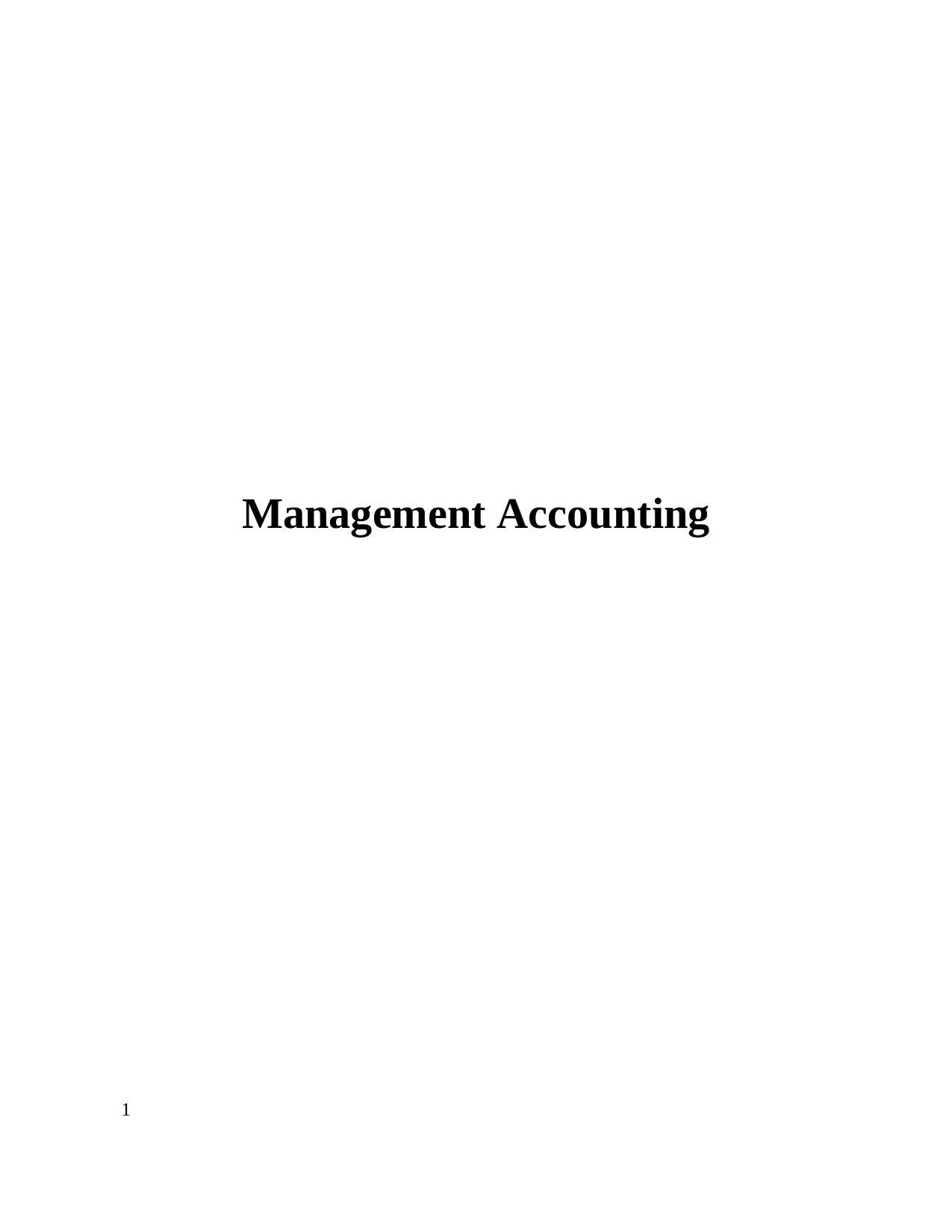
Management Accounting
1
1
Secure Best Marks with AI Grader
Need help grading? Try our AI Grader for instant feedback on your assignments.
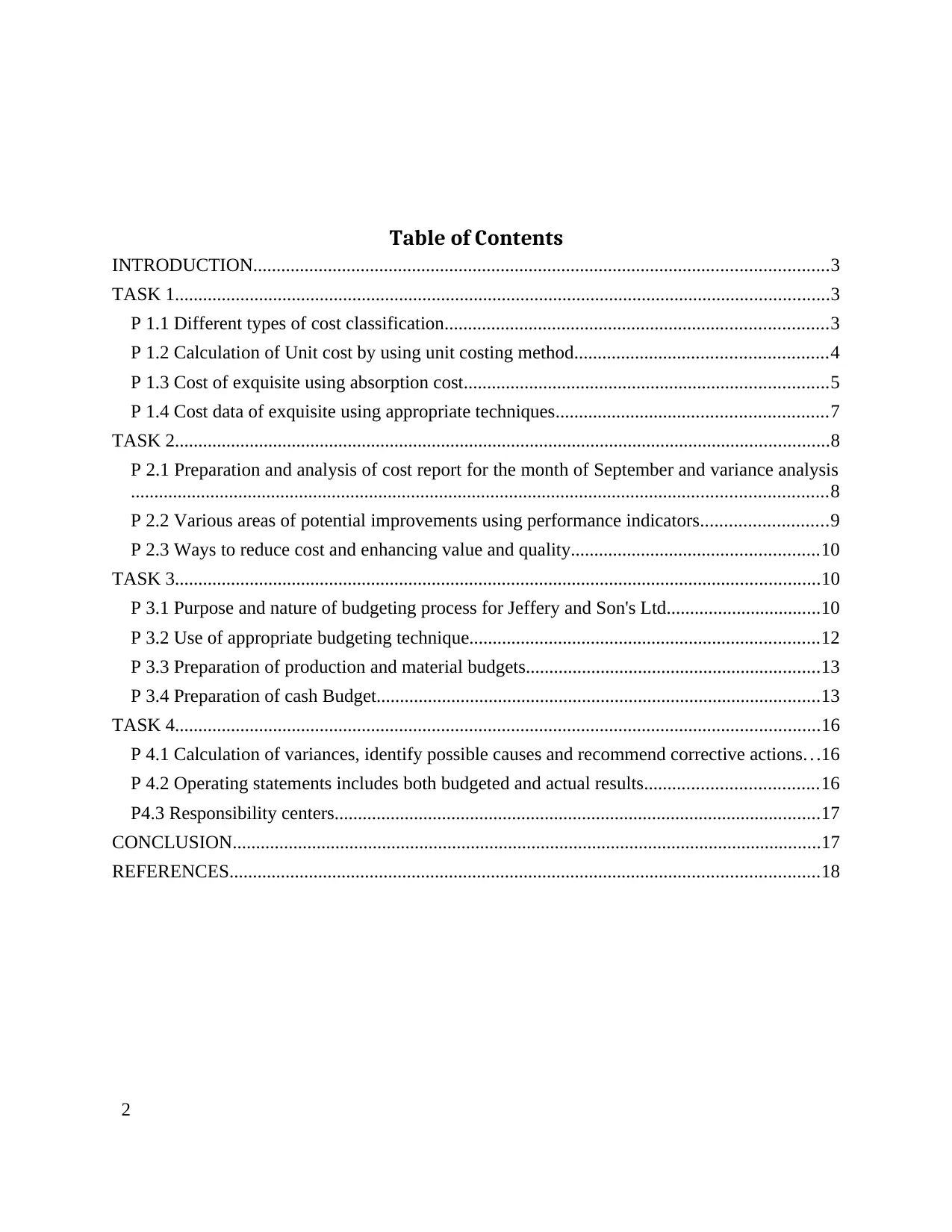
Table of Contents
INTRODUCTION...........................................................................................................................3
TASK 1............................................................................................................................................3
P 1.1 Different types of cost classification..................................................................................3
P 1.2 Calculation of Unit cost by using unit costing method......................................................4
P 1.3 Cost of exquisite using absorption cost..............................................................................5
P 1.4 Cost data of exquisite using appropriate techniques..........................................................7
TASK 2............................................................................................................................................8
P 2.1 Preparation and analysis of cost report for the month of September and variance analysis
.....................................................................................................................................................8
P 2.2 Various areas of potential improvements using performance indicators...........................9
P 2.3 Ways to reduce cost and enhancing value and quality.....................................................10
TASK 3..........................................................................................................................................10
P 3.1 Purpose and nature of budgeting process for Jeffery and Son's Ltd.................................10
P 3.2 Use of appropriate budgeting technique...........................................................................12
P 3.3 Preparation of production and material budgets...............................................................13
P 3.4 Preparation of cash Budget...............................................................................................13
TASK 4..........................................................................................................................................16
P 4.1 Calculation of variances, identify possible causes and recommend corrective actions. . .16
P 4.2 Operating statements includes both budgeted and actual results.....................................16
P4.3 Responsibility centers........................................................................................................17
CONCLUSION..............................................................................................................................17
REFERENCES..............................................................................................................................18
2
INTRODUCTION...........................................................................................................................3
TASK 1............................................................................................................................................3
P 1.1 Different types of cost classification..................................................................................3
P 1.2 Calculation of Unit cost by using unit costing method......................................................4
P 1.3 Cost of exquisite using absorption cost..............................................................................5
P 1.4 Cost data of exquisite using appropriate techniques..........................................................7
TASK 2............................................................................................................................................8
P 2.1 Preparation and analysis of cost report for the month of September and variance analysis
.....................................................................................................................................................8
P 2.2 Various areas of potential improvements using performance indicators...........................9
P 2.3 Ways to reduce cost and enhancing value and quality.....................................................10
TASK 3..........................................................................................................................................10
P 3.1 Purpose and nature of budgeting process for Jeffery and Son's Ltd.................................10
P 3.2 Use of appropriate budgeting technique...........................................................................12
P 3.3 Preparation of production and material budgets...............................................................13
P 3.4 Preparation of cash Budget...............................................................................................13
TASK 4..........................................................................................................................................16
P 4.1 Calculation of variances, identify possible causes and recommend corrective actions. . .16
P 4.2 Operating statements includes both budgeted and actual results.....................................16
P4.3 Responsibility centers........................................................................................................17
CONCLUSION..............................................................................................................................17
REFERENCES..............................................................................................................................18
2

INTRODUCTION
Management accounting is also termed as managerial accounting that combines norms
which are related to costing and budgeting. This unit of accounting is significantly used by the
managers in order to collect data for making a good use of accounting information for decision
making (Ward, 2012). From past few decades, management accounting is being used in
corporate world to decide financial matters within the organization. The case scenario of Jeffrey
and Son’s manufacturing company is taken into consideration for making present report.
Furthermore, cost report is prepared for a manufacturing unit while using various performance
indicators to find out the areas of potential improvements. The purpose as well as the nature of
the budgeting process is explained to the budget holders of Jeffery and Son’s Ltd. In this respect,
different kinds of budgets such as a production budget in units; materials purchases budget and a
cash budget are prepared. At the end of the report, variance in budget is identified along with
possible causes and recommended corrective actions.
TASK 1
P 1.1 Different types of cost classification
Manufacturing company bears expenses at the time of production of goods and services,
which is generally known as “Cost”. Nonetheless, there are various cost incurred during the
production process that are further classified into various categories. In general form, the cost is
classified on the basis elements; namely behaviors, nature and function. Following points will
explain the cost classification:
Elements of cost: The cost includes three major elements which are Material, Labor and
Expenses. Material is used to produce finished goods, labor put efficiency in production and
expenses are occurred in whole process. However, these elements are further divided into direct
and indirect forms such as direct material and indirect material (Zimmerman and Yahya-Zadeh,
2011).
Nature of Expense: On the basis of nature of cost, it is divided into material, labor and
expenses. Within the manufacturing company, the remuneration paid to workforce is considered
as labor cost. Material cost, on the other hand, is paid against the purchase of raw material that is
3
Management accounting is also termed as managerial accounting that combines norms
which are related to costing and budgeting. This unit of accounting is significantly used by the
managers in order to collect data for making a good use of accounting information for decision
making (Ward, 2012). From past few decades, management accounting is being used in
corporate world to decide financial matters within the organization. The case scenario of Jeffrey
and Son’s manufacturing company is taken into consideration for making present report.
Furthermore, cost report is prepared for a manufacturing unit while using various performance
indicators to find out the areas of potential improvements. The purpose as well as the nature of
the budgeting process is explained to the budget holders of Jeffery and Son’s Ltd. In this respect,
different kinds of budgets such as a production budget in units; materials purchases budget and a
cash budget are prepared. At the end of the report, variance in budget is identified along with
possible causes and recommended corrective actions.
TASK 1
P 1.1 Different types of cost classification
Manufacturing company bears expenses at the time of production of goods and services,
which is generally known as “Cost”. Nonetheless, there are various cost incurred during the
production process that are further classified into various categories. In general form, the cost is
classified on the basis elements; namely behaviors, nature and function. Following points will
explain the cost classification:
Elements of cost: The cost includes three major elements which are Material, Labor and
Expenses. Material is used to produce finished goods, labor put efficiency in production and
expenses are occurred in whole process. However, these elements are further divided into direct
and indirect forms such as direct material and indirect material (Zimmerman and Yahya-Zadeh,
2011).
Nature of Expense: On the basis of nature of cost, it is divided into material, labor and
expenses. Within the manufacturing company, the remuneration paid to workforce is considered
as labor cost. Material cost, on the other hand, is paid against the purchase of raw material that is
3

used by the company for successful accomplishment of manufacturing process. All the expenses
made for providing services are expenses for a manufacturing unit (Nørreklit, 2010).
Functions/Activities: According to the functions of different departments of business,
the cost is classified as per the expenses made by respective departments. For example:
Production cost, Selling cost, Administration cost, Marketing cost, Distribution cost and R&D
cost are included in function based cost.
Behavior of Cost: Volume is the base of deciding behavior of cost. On the other hand,
the cost which is based on the volume of production is categorized into behavioral category. Cost
of production changes as per the production volume of a specific time span. According to the
behavior, cost is classified into three major categories such as Fixed cost, Variable cost and Semi
variable cost (McGowan, 2010). Fixed cost does not modify at any level of production or
remains same at any production volume. However, variable cost has a nature of change due to
alteration in production volume. Semi-variable cost has characteristics of both fixed and variable
cost. It can be said that to a specific level that a cost remains fixed and after this level, it leads to
change. This kind of cost which occur in production process is called as semi-variable cost.
P 1.2 Calculation of Unit cost by using unit costing method
In general phenomenon, Job costing is referred as a method that is used by an
organization to compute cost for a job which is different and unique in nature and is to be
performed as per specific requirements of customers. The use of such costing methods allows
manufacturers to consider direct and indirect cost of the job at a same time. In respect with
Jeffrey and Son’s manufacturing Ltd., the calculation of cost and unit cost of job 444 is
explained below:
Table 1: Calculation of cost and unit cost of Job 444
Particulars Amount (£)
Direct cost
Direct material 200
Direct labour 270
Indirect cost
Variable production overhead 180
Fixed production overhead 120
Cost per unit 770
4
made for providing services are expenses for a manufacturing unit (Nørreklit, 2010).
Functions/Activities: According to the functions of different departments of business,
the cost is classified as per the expenses made by respective departments. For example:
Production cost, Selling cost, Administration cost, Marketing cost, Distribution cost and R&D
cost are included in function based cost.
Behavior of Cost: Volume is the base of deciding behavior of cost. On the other hand,
the cost which is based on the volume of production is categorized into behavioral category. Cost
of production changes as per the production volume of a specific time span. According to the
behavior, cost is classified into three major categories such as Fixed cost, Variable cost and Semi
variable cost (McGowan, 2010). Fixed cost does not modify at any level of production or
remains same at any production volume. However, variable cost has a nature of change due to
alteration in production volume. Semi-variable cost has characteristics of both fixed and variable
cost. It can be said that to a specific level that a cost remains fixed and after this level, it leads to
change. This kind of cost which occur in production process is called as semi-variable cost.
P 1.2 Calculation of Unit cost by using unit costing method
In general phenomenon, Job costing is referred as a method that is used by an
organization to compute cost for a job which is different and unique in nature and is to be
performed as per specific requirements of customers. The use of such costing methods allows
manufacturers to consider direct and indirect cost of the job at a same time. In respect with
Jeffrey and Son’s manufacturing Ltd., the calculation of cost and unit cost of job 444 is
explained below:
Table 1: Calculation of cost and unit cost of Job 444
Particulars Amount (£)
Direct cost
Direct material 200
Direct labour 270
Indirect cost
Variable production overhead 180
Fixed production overhead 120
Cost per unit 770
4
Secure Best Marks with AI Grader
Need help grading? Try our AI Grader for instant feedback on your assignments.
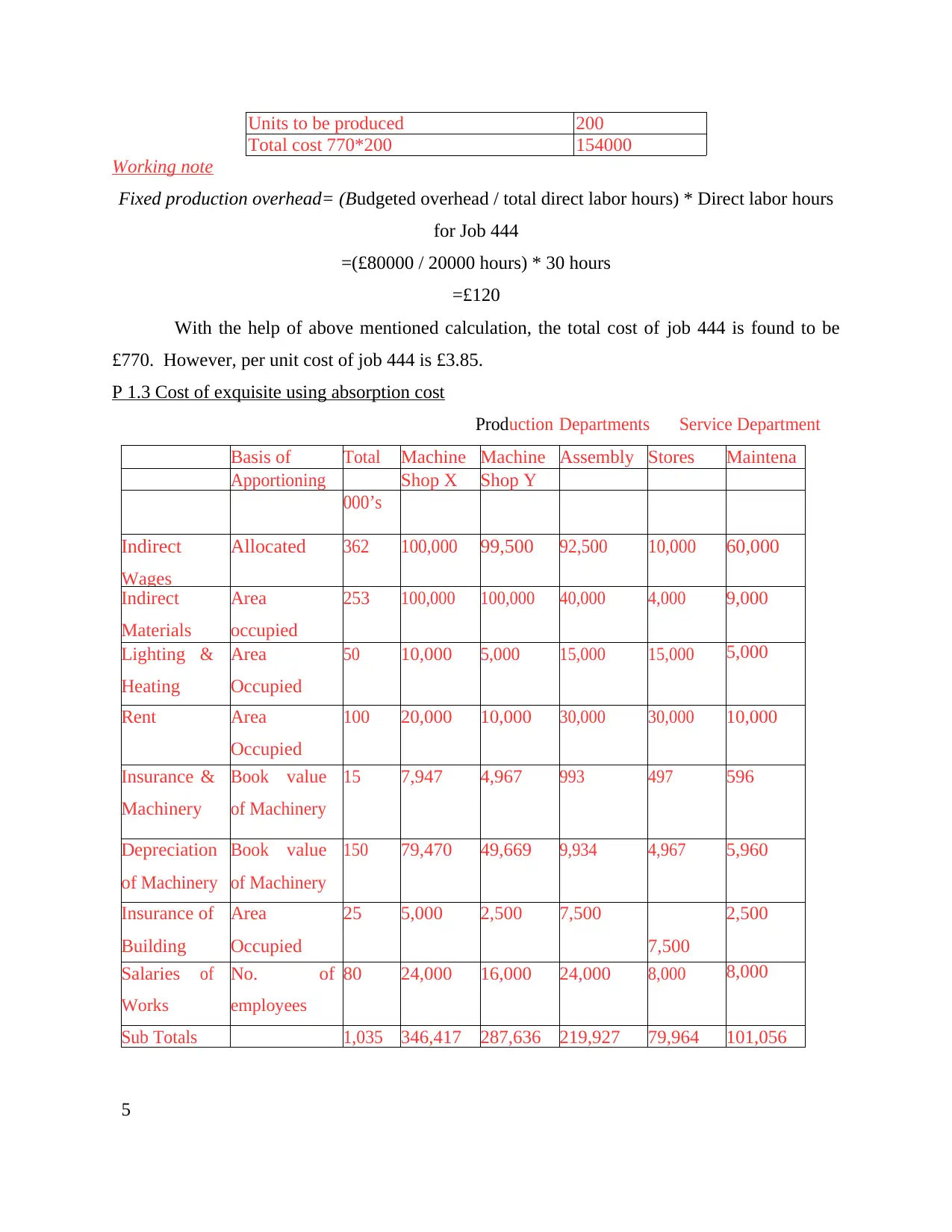
Units to be produced 200
Total cost 770*200 154000
Working note
Fixed production overhead= (Budgeted overhead / total direct labor hours) * Direct labor hours
for Job 444
=(£80000 / 20000 hours) * 30 hours
=£120
With the help of above mentioned calculation, the total cost of job 444 is found to be
£770. However, per unit cost of job 444 is £3.85.
P 1.3 Cost of exquisite using absorption cost
Production Departments Service Department
Basis of Total Machine Machine Assembly Stores Maintena
nceApportioning Shop X Shop Y
000’s
Indirect
Wages
Allocated 362 100,000 99,500 92,500 10,000 60,000
Indirect
Materials
Area
occupied
253 100,000 100,000 40,000 4,000 9,000
Lighting
Heating
& Area
Occupied
50 10,000 5,000 15,000 15,000 5,000
Rent Area
Occupied
100 20,000 10,000 30,000 30,000 10,000
Insurance &
Machinery
Book value
of Machinery
15 7,947 4,967 993 497 596
Depreciation
of Machinery
Book value
of Machinery
150 79,470 49,669 9,934 4,967 5,960
Insurance of
Building
Area
Occupied
25 5,000 2,500 7,500
7,500
2,500
Salaries
Works
of No.
employees
of 80 24,000 16,000 24,000 8,000 8,000
Sub Totals 1,035 346,417 287,636 219,927 79,964 101,056
5
Total cost 770*200 154000
Working note
Fixed production overhead= (Budgeted overhead / total direct labor hours) * Direct labor hours
for Job 444
=(£80000 / 20000 hours) * 30 hours
=£120
With the help of above mentioned calculation, the total cost of job 444 is found to be
£770. However, per unit cost of job 444 is £3.85.
P 1.3 Cost of exquisite using absorption cost
Production Departments Service Department
Basis of Total Machine Machine Assembly Stores Maintena
nceApportioning Shop X Shop Y
000’s
Indirect
Wages
Allocated 362 100,000 99,500 92,500 10,000 60,000
Indirect
Materials
Area
occupied
253 100,000 100,000 40,000 4,000 9,000
Lighting
Heating
& Area
Occupied
50 10,000 5,000 15,000 15,000 5,000
Rent Area
Occupied
100 20,000 10,000 30,000 30,000 10,000
Insurance &
Machinery
Book value
of Machinery
15 7,947 4,967 993 497 596
Depreciation
of Machinery
Book value
of Machinery
150 79,470 49,669 9,934 4,967 5,960
Insurance of
Building
Area
Occupied
25 5,000 2,500 7,500
7,500
2,500
Salaries
Works
of No.
employees
of 80 24,000 16,000 24,000 8,000 8,000
Sub Totals 1,035 346,417 287,636 219,927 79,964 101,056
5

Re-
of service
Stores Dept. 39,982 29,987 9,995 (79,964)
Maintenance 48,507 32,338 20,211 (101,056)
Totals 434,906 349,961 250,133 0 0
Working Note
Lighting & Heating: Machinery X 10/50 x £50,000 — f10,000
Machinery Y 5/50 x £50,000 — £5,000
Assembly 15/50 x £50,000 — f 15,000
Stores 15/50 x £50,000 = £15,000
Maintenance 5/50 x £50,000 = £15,000
Rent Machinery X 10/50 x £100,000 = f20,000
Machinery Y 5/50 x £100,000 = £10,000
Assembly 15/50 x £100,000 = £30,000 Stores
15/50 x £100,000= £30,000 Maintenance
5/50 x £100,000 = £10,000
Insurance & Machinery Machinery X 800/1510 x £15,000 = £7,964
Machinery Y 500/1510 x £15,000 — £4,966
Assembly 100/1510 x :E15,000 — £994 Stores
50/1510 x £15,000= f 497
Maintenance 5/1510 x f15,000= £596
Depreciation of Machinery Machinery X 800/1510 x £150,000 = £79,470
Machinery Y 500/1510 x £150,000 = £49,669
Assembly 100/1510 x £150,000 = £9,934
Stores 50/1510 x £150,000 — £497
Maintenance 60/1510 x £150,000 = £596
6
of service
Stores Dept. 39,982 29,987 9,995 (79,964)
Maintenance 48,507 32,338 20,211 (101,056)
Totals 434,906 349,961 250,133 0 0
Working Note
Lighting & Heating: Machinery X 10/50 x £50,000 — f10,000
Machinery Y 5/50 x £50,000 — £5,000
Assembly 15/50 x £50,000 — f 15,000
Stores 15/50 x £50,000 = £15,000
Maintenance 5/50 x £50,000 = £15,000
Rent Machinery X 10/50 x £100,000 = f20,000
Machinery Y 5/50 x £100,000 = £10,000
Assembly 15/50 x £100,000 = £30,000 Stores
15/50 x £100,000= £30,000 Maintenance
5/50 x £100,000 = £10,000
Insurance & Machinery Machinery X 800/1510 x £15,000 = £7,964
Machinery Y 500/1510 x £15,000 — £4,966
Assembly 100/1510 x :E15,000 — £994 Stores
50/1510 x £15,000= f 497
Maintenance 5/1510 x f15,000= £596
Depreciation of Machinery Machinery X 800/1510 x £150,000 = £79,470
Machinery Y 500/1510 x £150,000 = £49,669
Assembly 100/1510 x £150,000 = £9,934
Stores 50/1510 x £150,000 — £497
Maintenance 60/1510 x £150,000 = £596
6
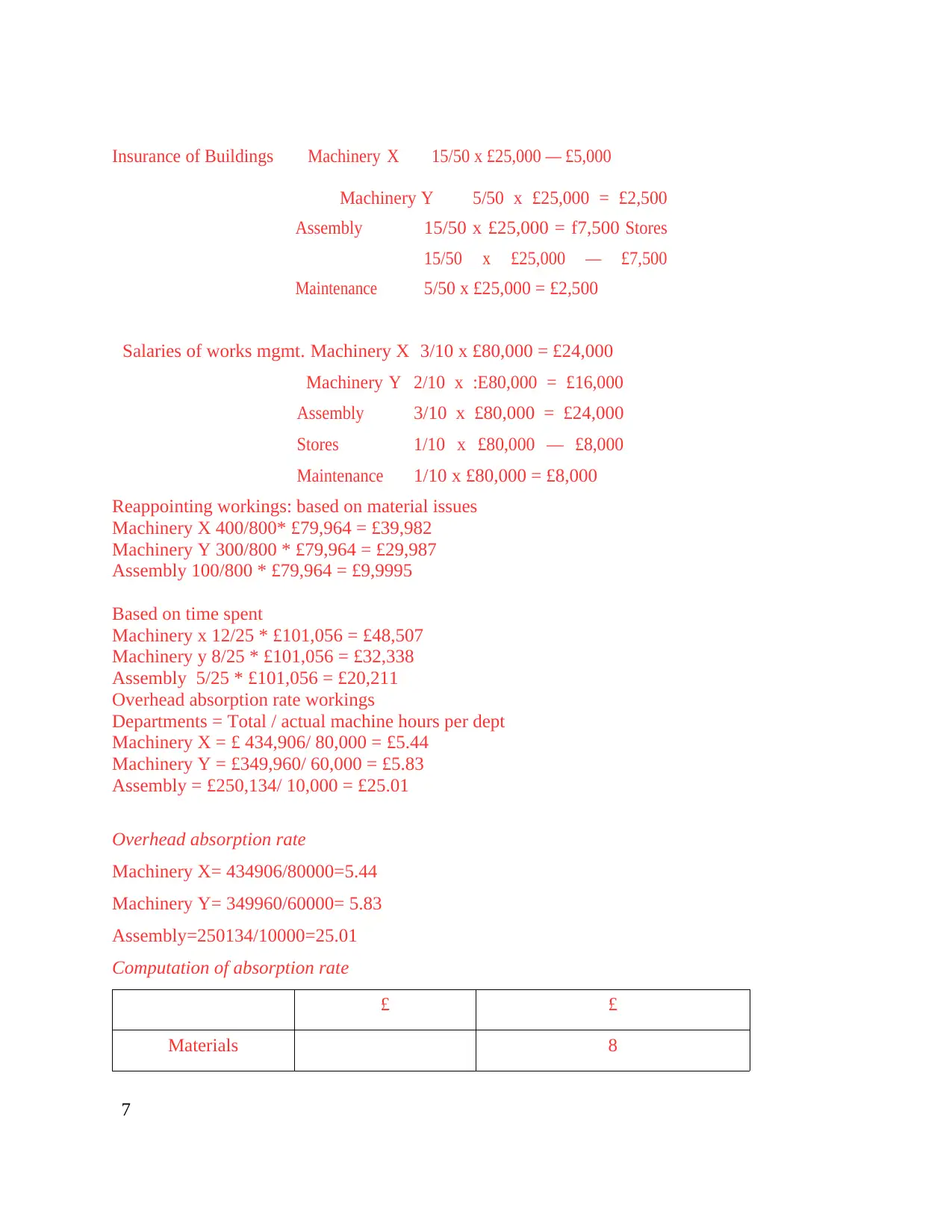
Insurance of Buildings Machinery X 15/50 x £25,000 — £5,000
Machinery Y 5/50 x £25,000 = £2,500
Assembly 15/50 x £25,000 = f7,500 Stores
15/50 x £25,000 — £7,500
Maintenance 5/50 x £25,000 = £2,500
Salaries of works mgmt. Machinery X 3/10 x £80,000 = £24,000
Machinery Y 2/10 x :E80,000 = £16,000
Assembly 3/10 x £80,000 = £24,000
Stores 1/10 x £80,000 — £8,000
Maintenance 1/10 x £80,000 = £8,000
Reappointing workings: based on material issues
Machinery X 400/800* £79,964 = £39,982
Machinery Y 300/800 * £79,964 = £29,987
Assembly 100/800 * £79,964 = £9,9995
Based on time spent
Machinery x 12/25 * £101,056 = £48,507
Machinery y 8/25 * £101,056 = £32,338
Assembly 5/25 * £101,056 = £20,211
Overhead absorption rate workings
Departments = Total / actual machine hours per dept
Machinery X = £ 434,906/ 80,000 = £5.44
Machinery Y = £349,960/ 60,000 = £5.83
Assembly = £250,134/ 10,000 = £25.01
Overhead absorption rate
Machinery X= 434906/80000=5.44
Machinery Y= 349960/60000= 5.83
Assembly=250134/10000=25.01
Computation of absorption rate
£ £
Materials 8
7
Machinery Y 5/50 x £25,000 = £2,500
Assembly 15/50 x £25,000 = f7,500 Stores
15/50 x £25,000 — £7,500
Maintenance 5/50 x £25,000 = £2,500
Salaries of works mgmt. Machinery X 3/10 x £80,000 = £24,000
Machinery Y 2/10 x :E80,000 = £16,000
Assembly 3/10 x £80,000 = £24,000
Stores 1/10 x £80,000 — £8,000
Maintenance 1/10 x £80,000 = £8,000
Reappointing workings: based on material issues
Machinery X 400/800* £79,964 = £39,982
Machinery Y 300/800 * £79,964 = £29,987
Assembly 100/800 * £79,964 = £9,9995
Based on time spent
Machinery x 12/25 * £101,056 = £48,507
Machinery y 8/25 * £101,056 = £32,338
Assembly 5/25 * £101,056 = £20,211
Overhead absorption rate workings
Departments = Total / actual machine hours per dept
Machinery X = £ 434,906/ 80,000 = £5.44
Machinery Y = £349,960/ 60,000 = £5.83
Assembly = £250,134/ 10,000 = £25.01
Overhead absorption rate
Machinery X= 434906/80000=5.44
Machinery Y= 349960/60000= 5.83
Assembly=250134/10000=25.01
Computation of absorption rate
£ £
Materials 8
7
Paraphrase This Document
Need a fresh take? Get an instant paraphrase of this document with our AI Paraphraser
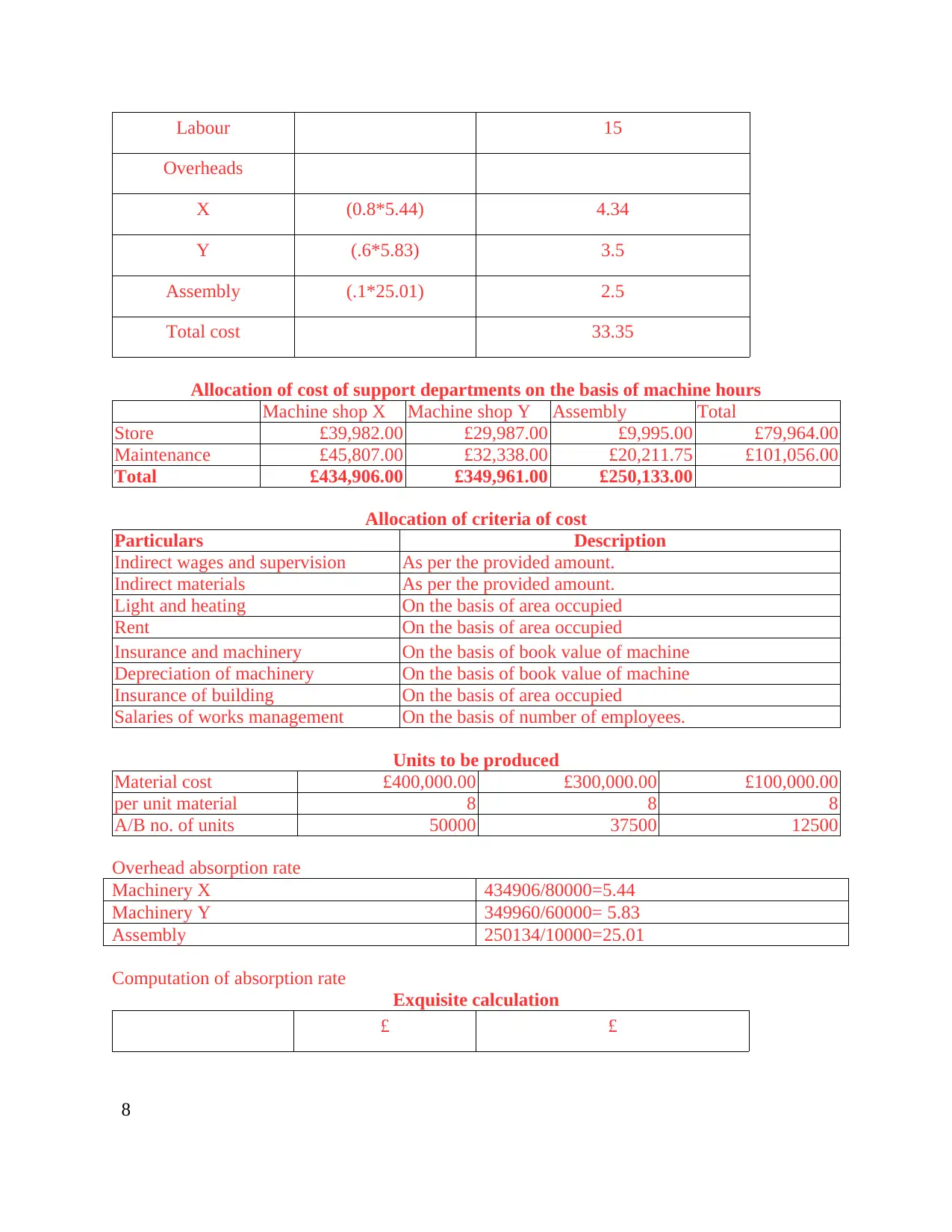
Labour 15
Overheads
X (0.8*5.44) 4.34
Y (.6*5.83) 3.5
Assembly (.1*25.01) 2.5
Total cost 33.35
Allocation of cost of support departments on the basis of machine hours
Machine shop X Machine shop Y Assembly Total
Store £39,982.00 £29,987.00 £9,995.00 £79,964.00
Maintenance £45,807.00 £32,338.00 £20,211.75 £101,056.00
Total £434,906.00 £349,961.00 £250,133.00
Allocation of criteria of cost
Particulars Description
Indirect wages and supervision As per the provided amount.
Indirect materials As per the provided amount.
Light and heating On the basis of area occupied
Rent On the basis of area occupied
Insurance and machinery On the basis of book value of machine
Depreciation of machinery On the basis of book value of machine
Insurance of building On the basis of area occupied
Salaries of works management On the basis of number of employees.
Units to be produced
Material cost £400,000.00 £300,000.00 £100,000.00
per unit material 8 8 8
A/B no. of units 50000 37500 12500
Overhead absorption rate
Machinery X 434906/80000=5.44
Machinery Y 349960/60000= 5.83
Assembly 250134/10000=25.01
Computation of absorption rate
Exquisite calculation
£ £
8
Overheads
X (0.8*5.44) 4.34
Y (.6*5.83) 3.5
Assembly (.1*25.01) 2.5
Total cost 33.35
Allocation of cost of support departments on the basis of machine hours
Machine shop X Machine shop Y Assembly Total
Store £39,982.00 £29,987.00 £9,995.00 £79,964.00
Maintenance £45,807.00 £32,338.00 £20,211.75 £101,056.00
Total £434,906.00 £349,961.00 £250,133.00
Allocation of criteria of cost
Particulars Description
Indirect wages and supervision As per the provided amount.
Indirect materials As per the provided amount.
Light and heating On the basis of area occupied
Rent On the basis of area occupied
Insurance and machinery On the basis of book value of machine
Depreciation of machinery On the basis of book value of machine
Insurance of building On the basis of area occupied
Salaries of works management On the basis of number of employees.
Units to be produced
Material cost £400,000.00 £300,000.00 £100,000.00
per unit material 8 8 8
A/B no. of units 50000 37500 12500
Overhead absorption rate
Machinery X 434906/80000=5.44
Machinery Y 349960/60000= 5.83
Assembly 250134/10000=25.01
Computation of absorption rate
Exquisite calculation
£ £
8
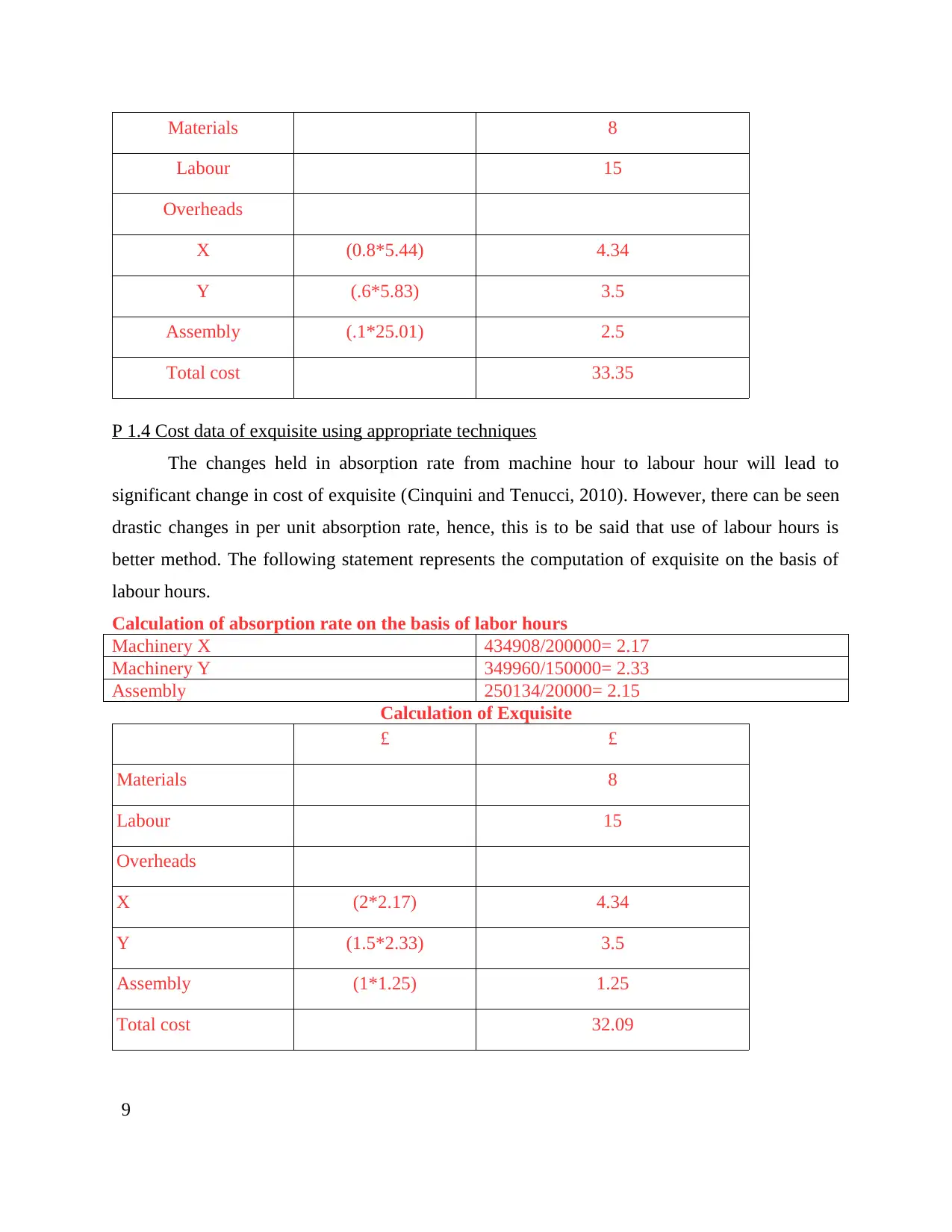
Materials 8
Labour 15
Overheads
X (0.8*5.44) 4.34
Y (.6*5.83) 3.5
Assembly (.1*25.01) 2.5
Total cost 33.35
P 1.4 Cost data of exquisite using appropriate techniques
The changes held in absorption rate from machine hour to labour hour will lead to
significant change in cost of exquisite (Cinquini and Tenucci, 2010). However, there can be seen
drastic changes in per unit absorption rate, hence, this is to be said that use of labour hours is
better method. The following statement represents the computation of exquisite on the basis of
labour hours.
Calculation of absorption rate on the basis of labor hours
Machinery X 434908/200000= 2.17
Machinery Y 349960/150000= 2.33
Assembly 250134/20000= 2.15
Calculation of Exquisite
£ £
Materials 8
Labour 15
Overheads
X (2*2.17) 4.34
Y (1.5*2.33) 3.5
Assembly (1*1.25) 1.25
Total cost 32.09
9
Labour 15
Overheads
X (0.8*5.44) 4.34
Y (.6*5.83) 3.5
Assembly (.1*25.01) 2.5
Total cost 33.35
P 1.4 Cost data of exquisite using appropriate techniques
The changes held in absorption rate from machine hour to labour hour will lead to
significant change in cost of exquisite (Cinquini and Tenucci, 2010). However, there can be seen
drastic changes in per unit absorption rate, hence, this is to be said that use of labour hours is
better method. The following statement represents the computation of exquisite on the basis of
labour hours.
Calculation of absorption rate on the basis of labor hours
Machinery X 434908/200000= 2.17
Machinery Y 349960/150000= 2.33
Assembly 250134/20000= 2.15
Calculation of Exquisite
£ £
Materials 8
Labour 15
Overheads
X (2*2.17) 4.34
Y (1.5*2.33) 3.5
Assembly (1*1.25) 1.25
Total cost 32.09
9
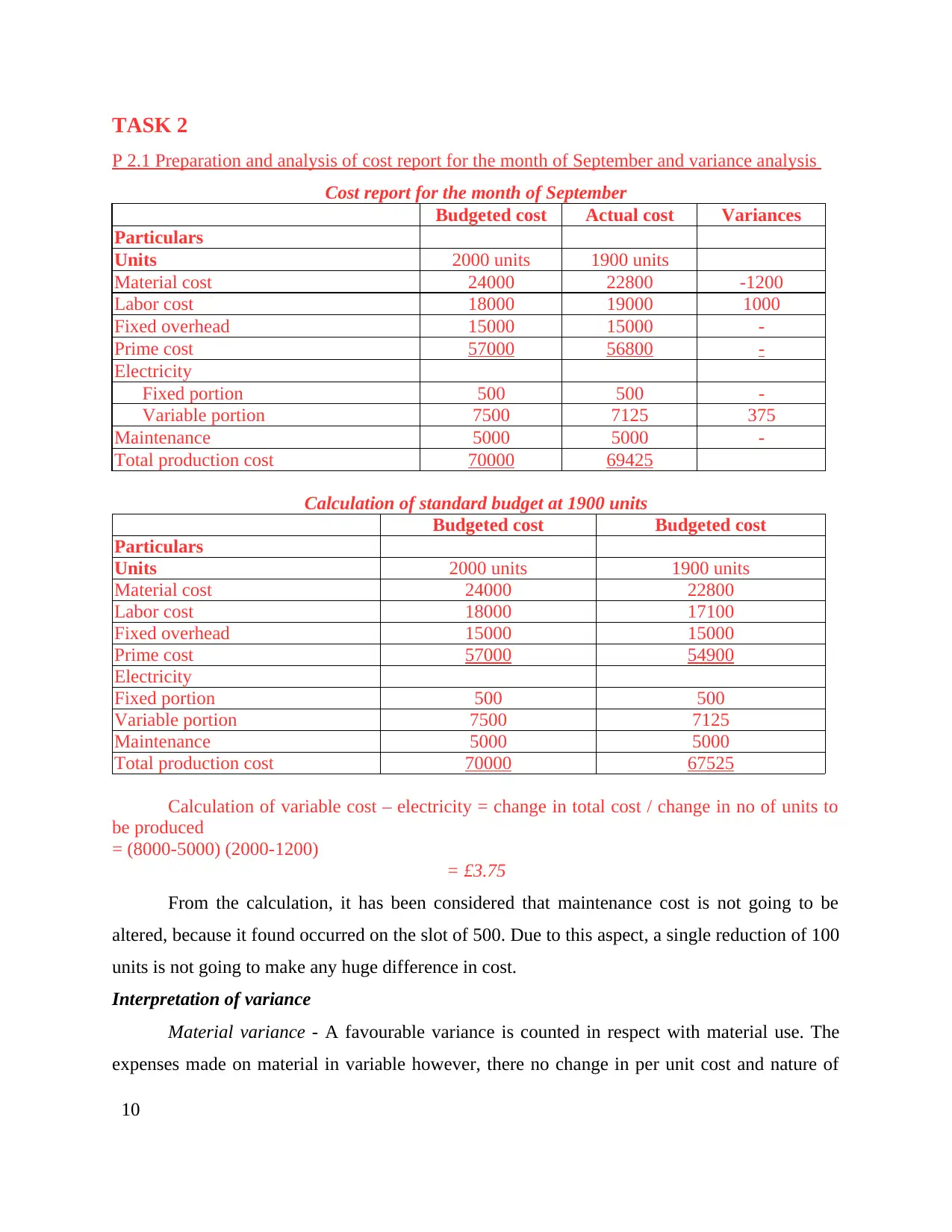
TASK 2
P 2.1 Preparation and analysis of cost report for the month of September and variance analysis
Cost report for the month of September
Budgeted cost Actual cost Variances
Particulars
Units 2000 units 1900 units
Material cost 24000 22800 -1200
Labor cost 18000 19000 1000
Fixed overhead 15000 15000 -
Prime cost 57000 56800 -
Electricity
Fixed portion 500 500 -
Variable portion 7500 7125 375
Maintenance 5000 5000 -
Total production cost 70000 69425
Calculation of standard budget at 1900 units
Budgeted cost Budgeted cost
Particulars
Units 2000 units 1900 units
Material cost 24000 22800
Labor cost 18000 17100
Fixed overhead 15000 15000
Prime cost 57000 54900
Electricity
Fixed portion 500 500
Variable portion 7500 7125
Maintenance 5000 5000
Total production cost 70000 67525
Calculation of variable cost – electricity = change in total cost / change in no of units to
be produced
= (8000-5000) (2000-1200)
= £3.75
From the calculation, it has been considered that maintenance cost is not going to be
altered, because it found occurred on the slot of 500. Due to this aspect, a single reduction of 100
units is not going to make any huge difference in cost.
Interpretation of variance
Material variance - A favourable variance is counted in respect with material use. The
expenses made on material in variable however, there no change in per unit cost and nature of
10
P 2.1 Preparation and analysis of cost report for the month of September and variance analysis
Cost report for the month of September
Budgeted cost Actual cost Variances
Particulars
Units 2000 units 1900 units
Material cost 24000 22800 -1200
Labor cost 18000 19000 1000
Fixed overhead 15000 15000 -
Prime cost 57000 56800 -
Electricity
Fixed portion 500 500 -
Variable portion 7500 7125 375
Maintenance 5000 5000 -
Total production cost 70000 69425
Calculation of standard budget at 1900 units
Budgeted cost Budgeted cost
Particulars
Units 2000 units 1900 units
Material cost 24000 22800
Labor cost 18000 17100
Fixed overhead 15000 15000
Prime cost 57000 54900
Electricity
Fixed portion 500 500
Variable portion 7500 7125
Maintenance 5000 5000
Total production cost 70000 67525
Calculation of variable cost – electricity = change in total cost / change in no of units to
be produced
= (8000-5000) (2000-1200)
= £3.75
From the calculation, it has been considered that maintenance cost is not going to be
altered, because it found occurred on the slot of 500. Due to this aspect, a single reduction of 100
units is not going to make any huge difference in cost.
Interpretation of variance
Material variance - A favourable variance is counted in respect with material use. The
expenses made on material in variable however, there no change in per unit cost and nature of
10
Secure Best Marks with AI Grader
Need help grading? Try our AI Grader for instant feedback on your assignments.
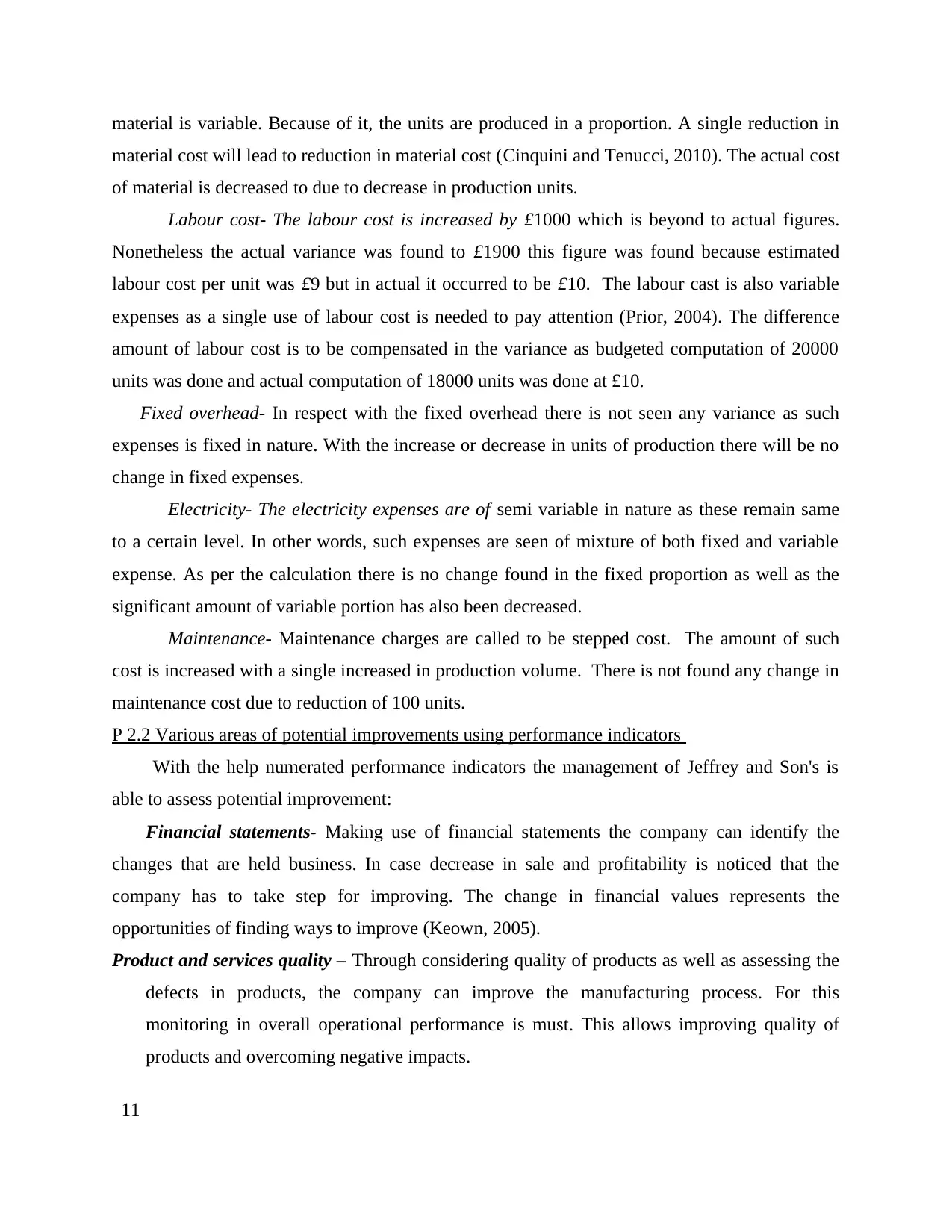
material is variable. Because of it, the units are produced in a proportion. A single reduction in
material cost will lead to reduction in material cost (Cinquini and Tenucci, 2010). The actual cost
of material is decreased to due to decrease in production units.
Labour cost- The labour cost is increased by £1000 which is beyond to actual figures.
Nonetheless the actual variance was found to £1900 this figure was found because estimated
labour cost per unit was £9 but in actual it occurred to be £10. The labour cast is also variable
expenses as a single use of labour cost is needed to pay attention (Prior, 2004). The difference
amount of labour cost is to be compensated in the variance as budgeted computation of 20000
units was done and actual computation of 18000 units was done at £10.
Fixed overhead- In respect with the fixed overhead there is not seen any variance as such
expenses is fixed in nature. With the increase or decrease in units of production there will be no
change in fixed expenses.
Electricity- The electricity expenses are of semi variable in nature as these remain same
to a certain level. In other words, such expenses are seen of mixture of both fixed and variable
expense. As per the calculation there is no change found in the fixed proportion as well as the
significant amount of variable portion has also been decreased.
Maintenance- Maintenance charges are called to be stepped cost. The amount of such
cost is increased with a single increased in production volume. There is not found any change in
maintenance cost due to reduction of 100 units.
P 2.2 Various areas of potential improvements using performance indicators
With the help numerated performance indicators the management of Jeffrey and Son's is
able to assess potential improvement:
Financial statements- Making use of financial statements the company can identify the
changes that are held business. In case decrease in sale and profitability is noticed that the
company has to take step for improving. The change in financial values represents the
opportunities of finding ways to improve (Keown, 2005).
Product and services quality – Through considering quality of products as well as assessing the
defects in products, the company can improve the manufacturing process. For this
monitoring in overall operational performance is must. This allows improving quality of
products and overcoming negative impacts.
11
material cost will lead to reduction in material cost (Cinquini and Tenucci, 2010). The actual cost
of material is decreased to due to decrease in production units.
Labour cost- The labour cost is increased by £1000 which is beyond to actual figures.
Nonetheless the actual variance was found to £1900 this figure was found because estimated
labour cost per unit was £9 but in actual it occurred to be £10. The labour cast is also variable
expenses as a single use of labour cost is needed to pay attention (Prior, 2004). The difference
amount of labour cost is to be compensated in the variance as budgeted computation of 20000
units was done and actual computation of 18000 units was done at £10.
Fixed overhead- In respect with the fixed overhead there is not seen any variance as such
expenses is fixed in nature. With the increase or decrease in units of production there will be no
change in fixed expenses.
Electricity- The electricity expenses are of semi variable in nature as these remain same
to a certain level. In other words, such expenses are seen of mixture of both fixed and variable
expense. As per the calculation there is no change found in the fixed proportion as well as the
significant amount of variable portion has also been decreased.
Maintenance- Maintenance charges are called to be stepped cost. The amount of such
cost is increased with a single increased in production volume. There is not found any change in
maintenance cost due to reduction of 100 units.
P 2.2 Various areas of potential improvements using performance indicators
With the help numerated performance indicators the management of Jeffrey and Son's is
able to assess potential improvement:
Financial statements- Making use of financial statements the company can identify the
changes that are held business. In case decrease in sale and profitability is noticed that the
company has to take step for improving. The change in financial values represents the
opportunities of finding ways to improve (Keown, 2005).
Product and services quality – Through considering quality of products as well as assessing the
defects in products, the company can improve the manufacturing process. For this
monitoring in overall operational performance is must. This allows improving quality of
products and overcoming negative impacts.
11
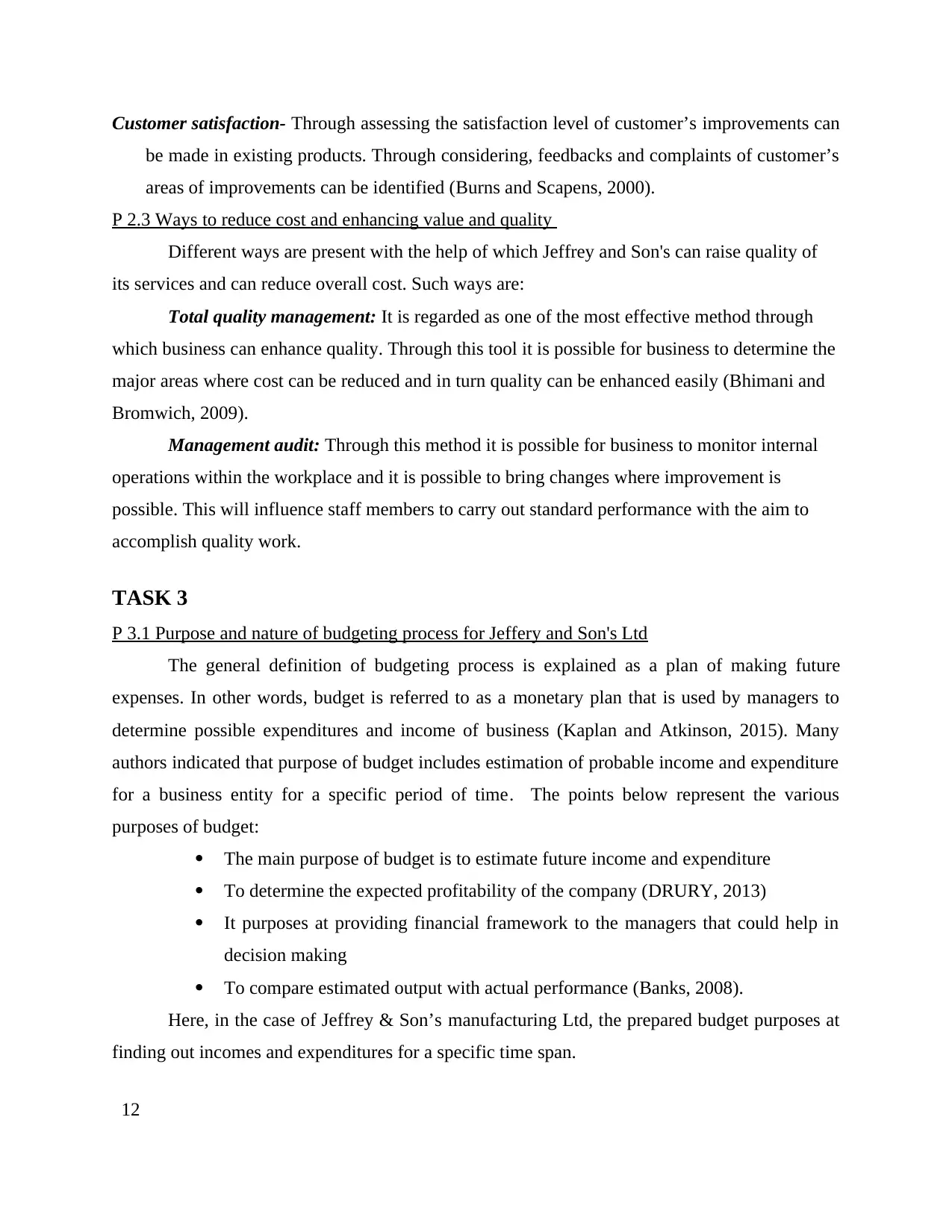
Customer satisfaction- Through assessing the satisfaction level of customer’s improvements can
be made in existing products. Through considering, feedbacks and complaints of customer’s
areas of improvements can be identified (Burns and Scapens, 2000).
P 2.3 Ways to reduce cost and enhancing value and quality
Different ways are present with the help of which Jeffrey and Son's can raise quality of
its services and can reduce overall cost. Such ways are:
Total quality management: It is regarded as one of the most effective method through
which business can enhance quality. Through this tool it is possible for business to determine the
major areas where cost can be reduced and in turn quality can be enhanced easily (Bhimani and
Bromwich, 2009).
Management audit: Through this method it is possible for business to monitor internal
operations within the workplace and it is possible to bring changes where improvement is
possible. This will influence staff members to carry out standard performance with the aim to
accomplish quality work.
TASK 3
P 3.1 Purpose and nature of budgeting process for Jeffery and Son's Ltd
The general definition of budgeting process is explained as a plan of making future
expenses. In other words, budget is referred to as a monetary plan that is used by managers to
determine possible expenditures and income of business (Kaplan and Atkinson, 2015). Many
authors indicated that purpose of budget includes estimation of probable income and expenditure
for a business entity for a specific period of time. The points below represent the various
purposes of budget:
The main purpose of budget is to estimate future income and expenditure
To determine the expected profitability of the company (DRURY, 2013)
It purposes at providing financial framework to the managers that could help in
decision making
To compare estimated output with actual performance (Banks, 2008).
Here, in the case of Jeffrey & Son’s manufacturing Ltd, the prepared budget purposes at
finding out incomes and expenditures for a specific time span.
12
be made in existing products. Through considering, feedbacks and complaints of customer’s
areas of improvements can be identified (Burns and Scapens, 2000).
P 2.3 Ways to reduce cost and enhancing value and quality
Different ways are present with the help of which Jeffrey and Son's can raise quality of
its services and can reduce overall cost. Such ways are:
Total quality management: It is regarded as one of the most effective method through
which business can enhance quality. Through this tool it is possible for business to determine the
major areas where cost can be reduced and in turn quality can be enhanced easily (Bhimani and
Bromwich, 2009).
Management audit: Through this method it is possible for business to monitor internal
operations within the workplace and it is possible to bring changes where improvement is
possible. This will influence staff members to carry out standard performance with the aim to
accomplish quality work.
TASK 3
P 3.1 Purpose and nature of budgeting process for Jeffery and Son's Ltd
The general definition of budgeting process is explained as a plan of making future
expenses. In other words, budget is referred to as a monetary plan that is used by managers to
determine possible expenditures and income of business (Kaplan and Atkinson, 2015). Many
authors indicated that purpose of budget includes estimation of probable income and expenditure
for a business entity for a specific period of time. The points below represent the various
purposes of budget:
The main purpose of budget is to estimate future income and expenditure
To determine the expected profitability of the company (DRURY, 2013)
It purposes at providing financial framework to the managers that could help in
decision making
To compare estimated output with actual performance (Banks, 2008).
Here, in the case of Jeffrey & Son’s manufacturing Ltd, the prepared budget purposes at
finding out incomes and expenditures for a specific time span.
12
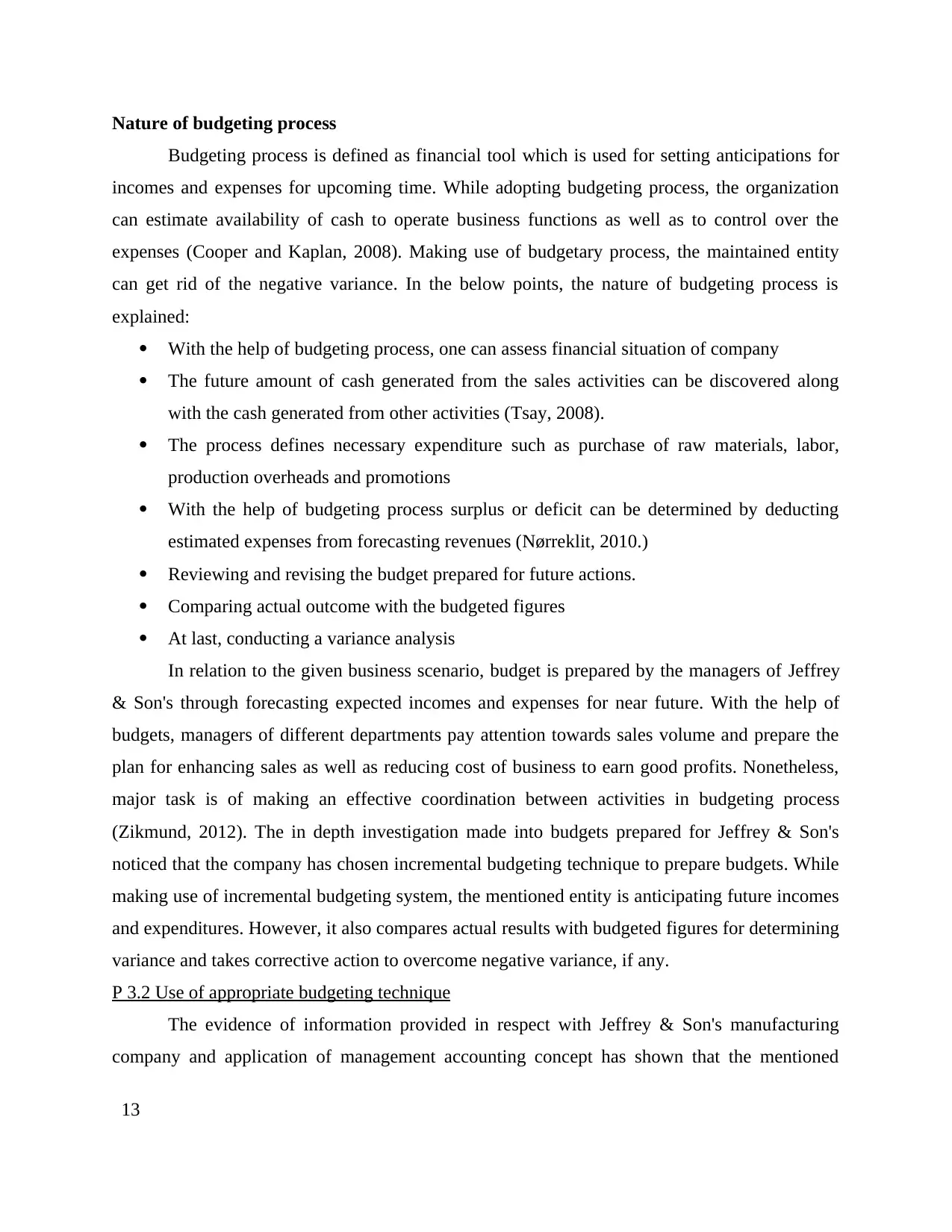
Nature of budgeting process
Budgeting process is defined as financial tool which is used for setting anticipations for
incomes and expenses for upcoming time. While adopting budgeting process, the organization
can estimate availability of cash to operate business functions as well as to control over the
expenses (Cooper and Kaplan, 2008). Making use of budgetary process, the maintained entity
can get rid of the negative variance. In the below points, the nature of budgeting process is
explained:
With the help of budgeting process, one can assess financial situation of company
The future amount of cash generated from the sales activities can be discovered along
with the cash generated from other activities (Tsay, 2008).
The process defines necessary expenditure such as purchase of raw materials, labor,
production overheads and promotions
With the help of budgeting process surplus or deficit can be determined by deducting
estimated expenses from forecasting revenues (Nørreklit, 2010.)
Reviewing and revising the budget prepared for future actions.
Comparing actual outcome with the budgeted figures
At last, conducting a variance analysis
In relation to the given business scenario, budget is prepared by the managers of Jeffrey
& Son's through forecasting expected incomes and expenses for near future. With the help of
budgets, managers of different departments pay attention towards sales volume and prepare the
plan for enhancing sales as well as reducing cost of business to earn good profits. Nonetheless,
major task is of making an effective coordination between activities in budgeting process
(Zikmund, 2012). The in depth investigation made into budgets prepared for Jeffrey & Son's
noticed that the company has chosen incremental budgeting technique to prepare budgets. While
making use of incremental budgeting system, the mentioned entity is anticipating future incomes
and expenditures. However, it also compares actual results with budgeted figures for determining
variance and takes corrective action to overcome negative variance, if any.
P 3.2 Use of appropriate budgeting technique
The evidence of information provided in respect with Jeffrey & Son's manufacturing
company and application of management accounting concept has shown that the mentioned
13
Budgeting process is defined as financial tool which is used for setting anticipations for
incomes and expenses for upcoming time. While adopting budgeting process, the organization
can estimate availability of cash to operate business functions as well as to control over the
expenses (Cooper and Kaplan, 2008). Making use of budgetary process, the maintained entity
can get rid of the negative variance. In the below points, the nature of budgeting process is
explained:
With the help of budgeting process, one can assess financial situation of company
The future amount of cash generated from the sales activities can be discovered along
with the cash generated from other activities (Tsay, 2008).
The process defines necessary expenditure such as purchase of raw materials, labor,
production overheads and promotions
With the help of budgeting process surplus or deficit can be determined by deducting
estimated expenses from forecasting revenues (Nørreklit, 2010.)
Reviewing and revising the budget prepared for future actions.
Comparing actual outcome with the budgeted figures
At last, conducting a variance analysis
In relation to the given business scenario, budget is prepared by the managers of Jeffrey
& Son's through forecasting expected incomes and expenses for near future. With the help of
budgets, managers of different departments pay attention towards sales volume and prepare the
plan for enhancing sales as well as reducing cost of business to earn good profits. Nonetheless,
major task is of making an effective coordination between activities in budgeting process
(Zikmund, 2012). The in depth investigation made into budgets prepared for Jeffrey & Son's
noticed that the company has chosen incremental budgeting technique to prepare budgets. While
making use of incremental budgeting system, the mentioned entity is anticipating future incomes
and expenditures. However, it also compares actual results with budgeted figures for determining
variance and takes corrective action to overcome negative variance, if any.
P 3.2 Use of appropriate budgeting technique
The evidence of information provided in respect with Jeffrey & Son's manufacturing
company and application of management accounting concept has shown that the mentioned
13
Paraphrase This Document
Need a fresh take? Get an instant paraphrase of this document with our AI Paraphraser
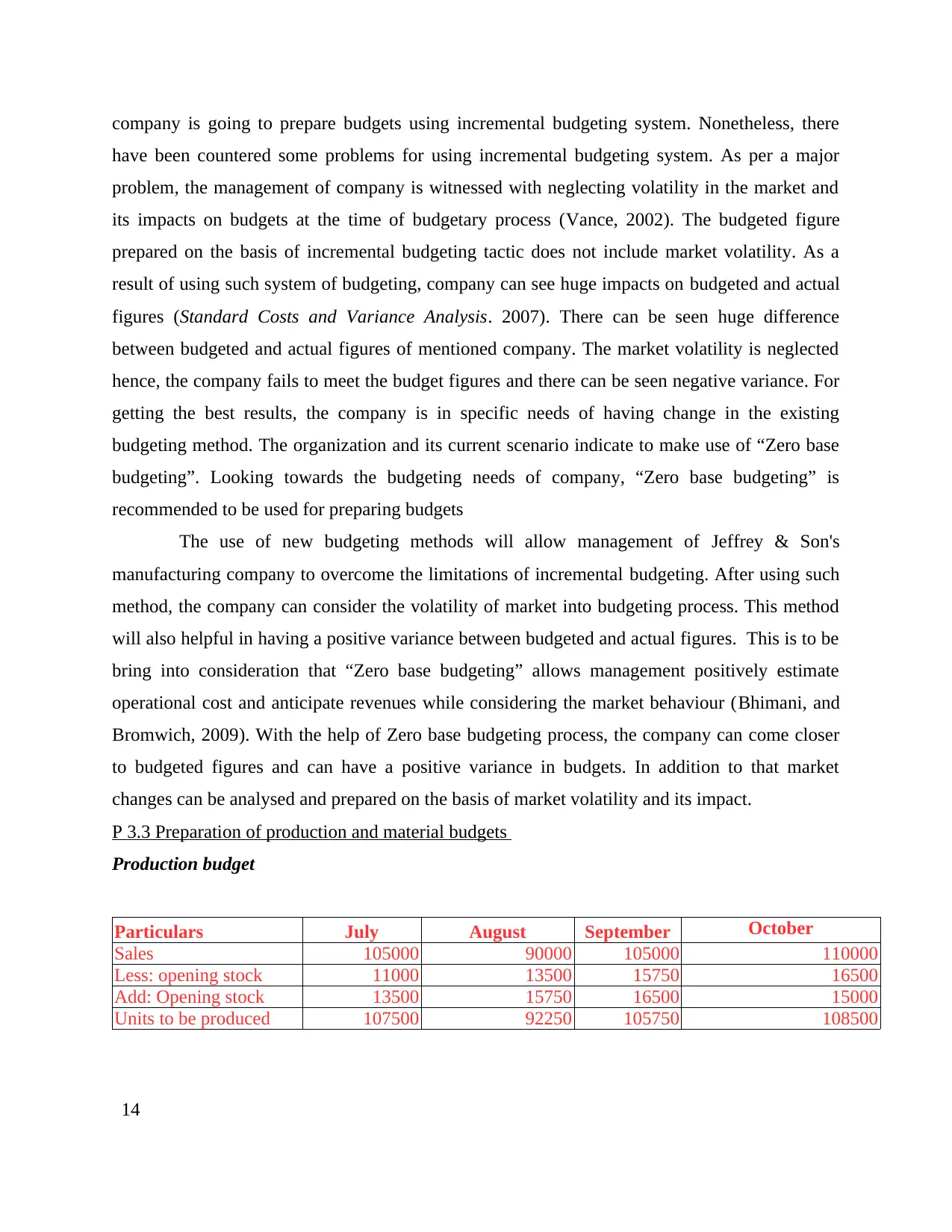
company is going to prepare budgets using incremental budgeting system. Nonetheless, there
have been countered some problems for using incremental budgeting system. As per a major
problem, the management of company is witnessed with neglecting volatility in the market and
its impacts on budgets at the time of budgetary process (Vance, 2002). The budgeted figure
prepared on the basis of incremental budgeting tactic does not include market volatility. As a
result of using such system of budgeting, company can see huge impacts on budgeted and actual
figures (Standard Costs and Variance Analysis. 2007). There can be seen huge difference
between budgeted and actual figures of mentioned company. The market volatility is neglected
hence, the company fails to meet the budget figures and there can be seen negative variance. For
getting the best results, the company is in specific needs of having change in the existing
budgeting method. The organization and its current scenario indicate to make use of “Zero base
budgeting”. Looking towards the budgeting needs of company, “Zero base budgeting” is
recommended to be used for preparing budgets
The use of new budgeting methods will allow management of Jeffrey & Son's
manufacturing company to overcome the limitations of incremental budgeting. After using such
method, the company can consider the volatility of market into budgeting process. This method
will also helpful in having a positive variance between budgeted and actual figures. This is to be
bring into consideration that “Zero base budgeting” allows management positively estimate
operational cost and anticipate revenues while considering the market behaviour (Bhimani, and
Bromwich, 2009). With the help of Zero base budgeting process, the company can come closer
to budgeted figures and can have a positive variance in budgets. In addition to that market
changes can be analysed and prepared on the basis of market volatility and its impact.
P 3.3 Preparation of production and material budgets
Production budget
Particulars July August September October
Sales 105000 90000 105000 110000
Less: opening stock 11000 13500 15750 16500
Add: Opening stock 13500 15750 16500 15000
Units to be produced 107500 92250 105750 108500
14
have been countered some problems for using incremental budgeting system. As per a major
problem, the management of company is witnessed with neglecting volatility in the market and
its impacts on budgets at the time of budgetary process (Vance, 2002). The budgeted figure
prepared on the basis of incremental budgeting tactic does not include market volatility. As a
result of using such system of budgeting, company can see huge impacts on budgeted and actual
figures (Standard Costs and Variance Analysis. 2007). There can be seen huge difference
between budgeted and actual figures of mentioned company. The market volatility is neglected
hence, the company fails to meet the budget figures and there can be seen negative variance. For
getting the best results, the company is in specific needs of having change in the existing
budgeting method. The organization and its current scenario indicate to make use of “Zero base
budgeting”. Looking towards the budgeting needs of company, “Zero base budgeting” is
recommended to be used for preparing budgets
The use of new budgeting methods will allow management of Jeffrey & Son's
manufacturing company to overcome the limitations of incremental budgeting. After using such
method, the company can consider the volatility of market into budgeting process. This method
will also helpful in having a positive variance between budgeted and actual figures. This is to be
bring into consideration that “Zero base budgeting” allows management positively estimate
operational cost and anticipate revenues while considering the market behaviour (Bhimani, and
Bromwich, 2009). With the help of Zero base budgeting process, the company can come closer
to budgeted figures and can have a positive variance in budgets. In addition to that market
changes can be analysed and prepared on the basis of market volatility and its impact.
P 3.3 Preparation of production and material budgets
Production budget
Particulars July August September October
Sales 105000 90000 105000 110000
Less: opening stock 11000 13500 15750 16500
Add: Opening stock 13500 15750 16500 15000
Units to be produced 107500 92250 105750 108500
14
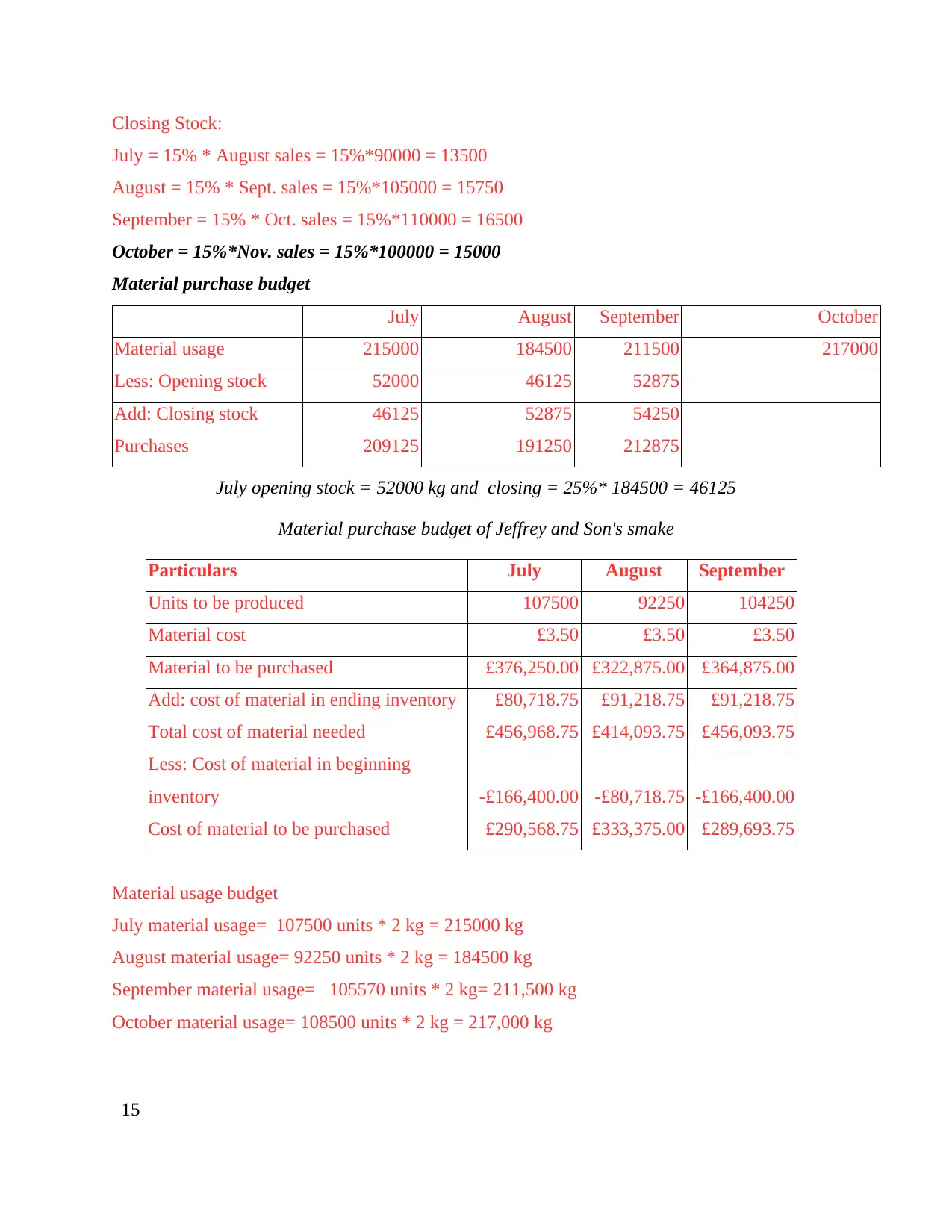
Closing Stock:
July = 15% * August sales = 15%*90000 = 13500
August = 15% * Sept. sales = 15%*105000 = 15750
September = 15% * Oct. sales = 15%*110000 = 16500
October = 15%*Nov. sales = 15%*100000 = 15000
Material purchase budget
July August September October
Material usage 215000 184500 211500 217000
Less: Opening stock 52000 46125 52875
Add: Closing stock 46125 52875 54250
Purchases 209125 191250 212875
July opening stock = 52000 kg and closing = 25%* 184500 = 46125
Material purchase budget of Jeffrey and Son's smake
Particulars July August September
Units to be produced 107500 92250 104250
Material cost £3.50 £3.50 £3.50
Material to be purchased £376,250.00 £322,875.00 £364,875.00
Add: cost of material in ending inventory £80,718.75 £91,218.75 £91,218.75
Total cost of material needed £456,968.75 £414,093.75 £456,093.75
Less: Cost of material in beginning
inventory -£166,400.00 -£80,718.75 -£166,400.00
Cost of material to be purchased £290,568.75 £333,375.00 £289,693.75
Material usage budget
July material usage= 107500 units * 2 kg = 215000 kg
August material usage= 92250 units * 2 kg = 184500 kg
September material usage= 105570 units * 2 kg= 211,500 kg
October material usage= 108500 units * 2 kg = 217,000 kg
15
July = 15% * August sales = 15%*90000 = 13500
August = 15% * Sept. sales = 15%*105000 = 15750
September = 15% * Oct. sales = 15%*110000 = 16500
October = 15%*Nov. sales = 15%*100000 = 15000
Material purchase budget
July August September October
Material usage 215000 184500 211500 217000
Less: Opening stock 52000 46125 52875
Add: Closing stock 46125 52875 54250
Purchases 209125 191250 212875
July opening stock = 52000 kg and closing = 25%* 184500 = 46125
Material purchase budget of Jeffrey and Son's smake
Particulars July August September
Units to be produced 107500 92250 104250
Material cost £3.50 £3.50 £3.50
Material to be purchased £376,250.00 £322,875.00 £364,875.00
Add: cost of material in ending inventory £80,718.75 £91,218.75 £91,218.75
Total cost of material needed £456,968.75 £414,093.75 £456,093.75
Less: Cost of material in beginning
inventory -£166,400.00 -£80,718.75 -£166,400.00
Cost of material to be purchased £290,568.75 £333,375.00 £289,693.75
Material usage budget
July material usage= 107500 units * 2 kg = 215000 kg
August material usage= 92250 units * 2 kg = 184500 kg
September material usage= 105570 units * 2 kg= 211,500 kg
October material usage= 108500 units * 2 kg = 217,000 kg
15

P 3.4 Preparation of cash Budget
Cash budget of Jeffrey and Son's smake
Particulars July August September
Opening balance of cash £16,000.00 £204,431.25 £192,306.25
Received from debtors £333,000.00 £335,250.00 £330,750.00
Cash sales £567,000.00 £486,000.00 £567,000.00
Total receivable £916,000.00 £1,025,681.25 £1,090,056.25
Expenses
Payment to creditors £290,568.75 £333,375.00 £289,693.75
Direct wages £300,000.00 £300,000.00 £300,000.00
Variable overhead £46,000.00 £100,000.00 £100,000.00
Fixed overhead £75,000.00 £100,000.00 £100,000.00
Total payable £711,568.75 £833,375.00 £789,693.75
Closing balance of cash £204,431.25 £192,306.25 £300,362.50
Working notes
Computation of amount receivable from debtors
July August September
Amount received for sales before a month 247500 236250 236250
Amount received for sales before two months 85500 99000 94500
Sum 333000 335250 330750
Computation of amount of overhead payment
Overhead payment July August September
Variable overhead 46000 100000 100000
Fixed overhead 75000 100000 100000
Computation of production cost
July August September
Material cost £3.50 £3.50 £3.50
Wages £3.00 £3.00 £3.00
Variable overhead £1.00 £1.00 £1.00
Total variable cost £7.50 £7.50 £7.50
Fixed overhead £100,000.00 £100,000.00 £100,000.00
Units to be produced 107500 92250 104250
Total variable cost £806,250.00 £691,875.00 £781,875.00
Total production cost £906,250.00 £791,875.00 £881,875.00
16
Cash budget of Jeffrey and Son's smake
Particulars July August September
Opening balance of cash £16,000.00 £204,431.25 £192,306.25
Received from debtors £333,000.00 £335,250.00 £330,750.00
Cash sales £567,000.00 £486,000.00 £567,000.00
Total receivable £916,000.00 £1,025,681.25 £1,090,056.25
Expenses
Payment to creditors £290,568.75 £333,375.00 £289,693.75
Direct wages £300,000.00 £300,000.00 £300,000.00
Variable overhead £46,000.00 £100,000.00 £100,000.00
Fixed overhead £75,000.00 £100,000.00 £100,000.00
Total payable £711,568.75 £833,375.00 £789,693.75
Closing balance of cash £204,431.25 £192,306.25 £300,362.50
Working notes
Computation of amount receivable from debtors
July August September
Amount received for sales before a month 247500 236250 236250
Amount received for sales before two months 85500 99000 94500
Sum 333000 335250 330750
Computation of amount of overhead payment
Overhead payment July August September
Variable overhead 46000 100000 100000
Fixed overhead 75000 100000 100000
Computation of production cost
July August September
Material cost £3.50 £3.50 £3.50
Wages £3.00 £3.00 £3.00
Variable overhead £1.00 £1.00 £1.00
Total variable cost £7.50 £7.50 £7.50
Fixed overhead £100,000.00 £100,000.00 £100,000.00
Units to be produced 107500 92250 104250
Total variable cost £806,250.00 £691,875.00 £781,875.00
Total production cost £906,250.00 £791,875.00 £881,875.00
16
Secure Best Marks with AI Grader
Need help grading? Try our AI Grader for instant feedback on your assignments.
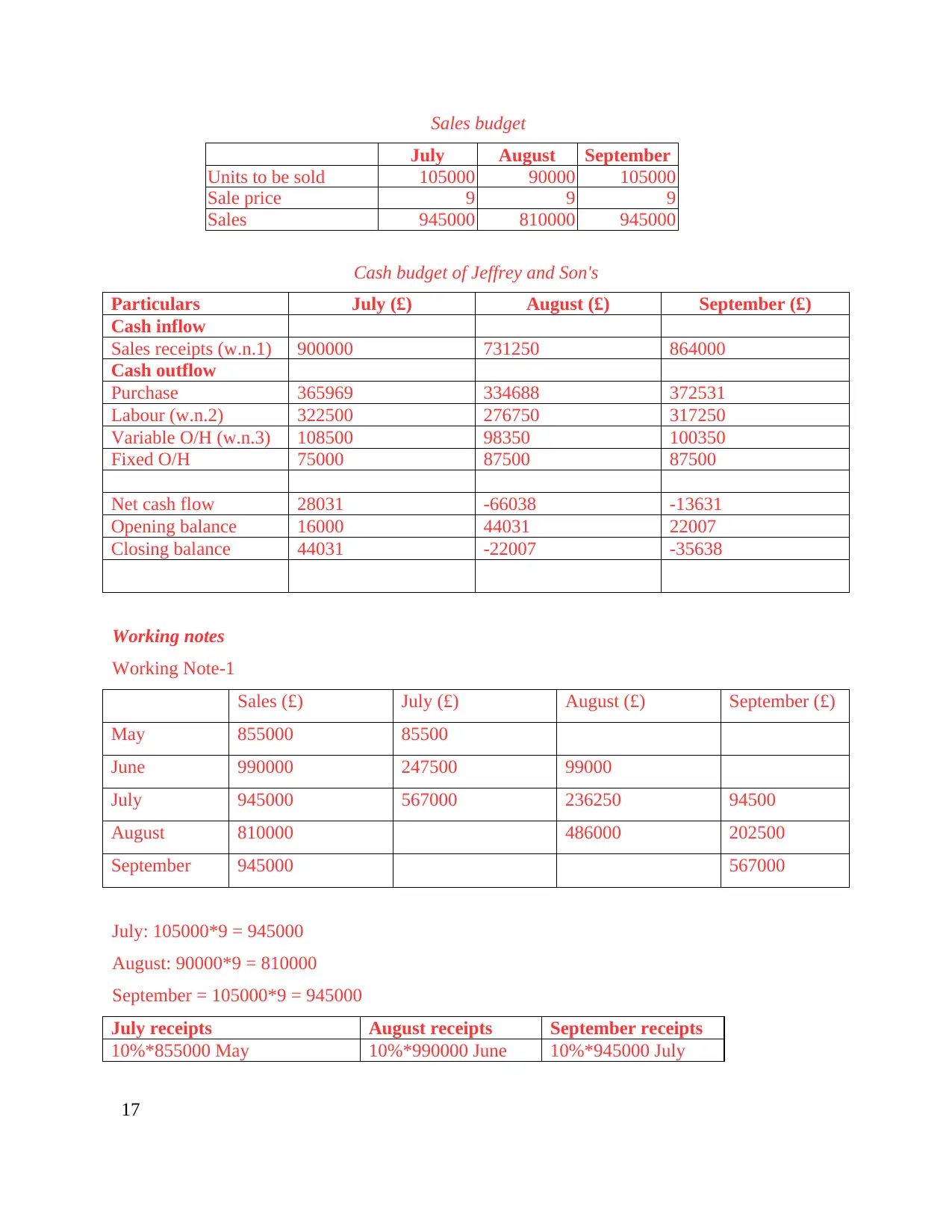
Sales budget
July August September
Units to be sold 105000 90000 105000
Sale price 9 9 9
Sales 945000 810000 945000
Cash budget of Jeffrey and Son's
Particulars July (£) August (£) September (£)
Cash inflow
Sales receipts (w.n.1) 900000 731250 864000
Cash outflow
Purchase 365969 334688 372531
Labour (w.n.2) 322500 276750 317250
Variable O/H (w.n.3) 108500 98350 100350
Fixed O/H 75000 87500 87500
Net cash flow 28031 -66038 -13631
Opening balance 16000 44031 22007
Closing balance 44031 -22007 -35638
Working notes
Working Note-1
Sales (£) July (£) August (£) September (£)
May 855000 85500
June 990000 247500 99000
July 945000 567000 236250 94500
August 810000 486000 202500
September 945000 567000
July: 105000*9 = 945000
August: 90000*9 = 810000
September = 105000*9 = 945000
July receipts August receipts September receipts
10%*855000 May 10%*990000 June 10%*945000 July
17
July August September
Units to be sold 105000 90000 105000
Sale price 9 9 9
Sales 945000 810000 945000
Cash budget of Jeffrey and Son's
Particulars July (£) August (£) September (£)
Cash inflow
Sales receipts (w.n.1) 900000 731250 864000
Cash outflow
Purchase 365969 334688 372531
Labour (w.n.2) 322500 276750 317250
Variable O/H (w.n.3) 108500 98350 100350
Fixed O/H 75000 87500 87500
Net cash flow 28031 -66038 -13631
Opening balance 16000 44031 22007
Closing balance 44031 -22007 -35638
Working notes
Working Note-1
Sales (£) July (£) August (£) September (£)
May 855000 85500
June 990000 247500 99000
July 945000 567000 236250 94500
August 810000 486000 202500
September 945000 567000
July: 105000*9 = 945000
August: 90000*9 = 810000
September = 105000*9 = 945000
July receipts August receipts September receipts
10%*855000 May 10%*990000 June 10%*945000 July
17
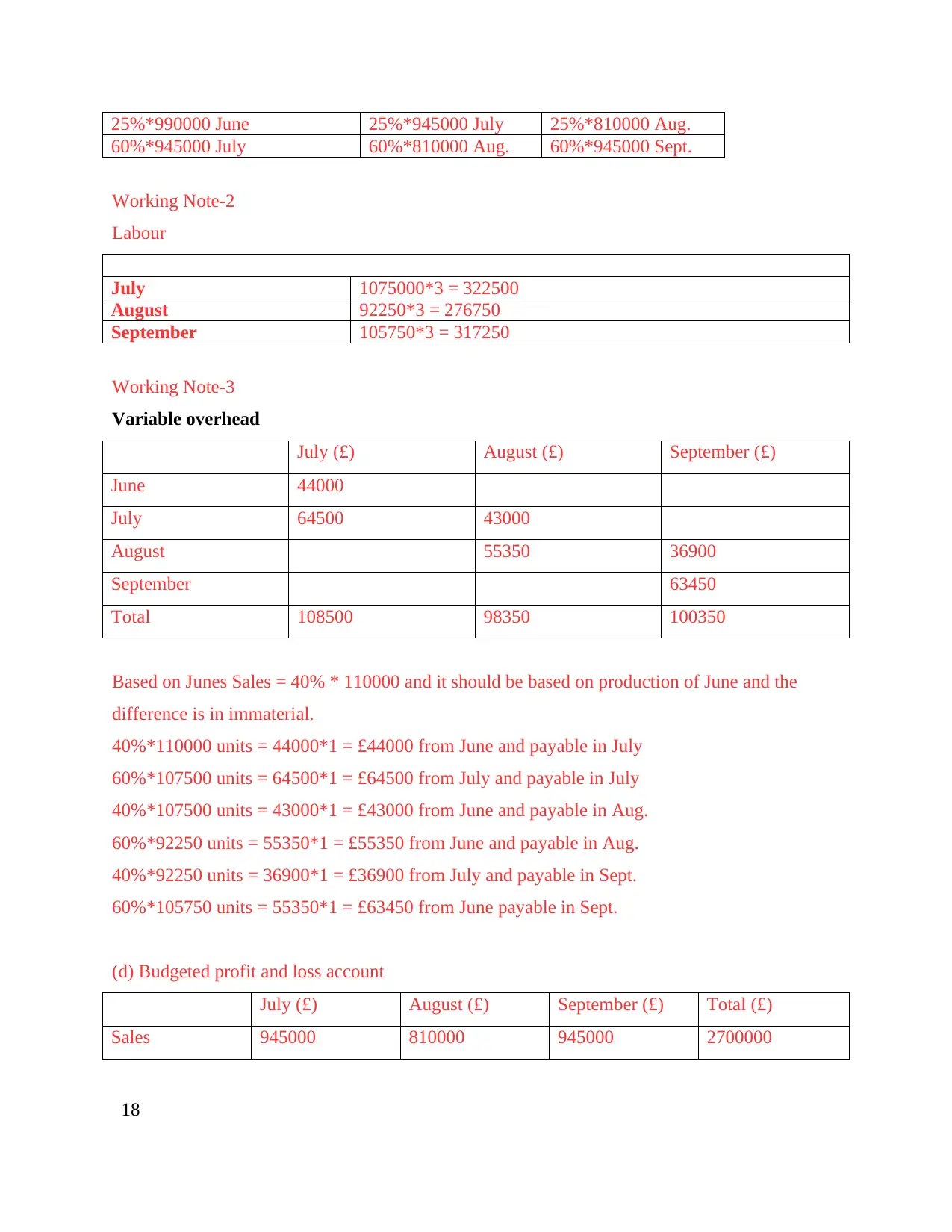
25%*990000 June 25%*945000 July 25%*810000 Aug.
60%*945000 July 60%*810000 Aug. 60%*945000 Sept.
Working Note-2
Labour
July 1075000*3 = 322500
August 92250*3 = 276750
September 105750*3 = 317250
Working Note-3
Variable overhead
July (£) August (£) September (£)
June 44000
July 64500 43000
August 55350 36900
September 63450
Total 108500 98350 100350
Based on Junes Sales = 40% * 110000 and it should be based on production of June and the
difference is in immaterial.
40%*110000 units = 44000*1 = £44000 from June and payable in July
60%*107500 units = 64500*1 = £64500 from July and payable in July
40%*107500 units = 43000*1 = £43000 from June and payable in Aug.
60%*92250 units = 55350*1 = £55350 from June and payable in Aug.
40%*92250 units = 36900*1 = £36900 from July and payable in Sept.
60%*105750 units = 55350*1 = £63450 from June payable in Sept.
(d) Budgeted profit and loss account
July (£) August (£) September (£) Total (£)
Sales 945000 810000 945000 2700000
18
60%*945000 July 60%*810000 Aug. 60%*945000 Sept.
Working Note-2
Labour
July 1075000*3 = 322500
August 92250*3 = 276750
September 105750*3 = 317250
Working Note-3
Variable overhead
July (£) August (£) September (£)
June 44000
July 64500 43000
August 55350 36900
September 63450
Total 108500 98350 100350
Based on Junes Sales = 40% * 110000 and it should be based on production of June and the
difference is in immaterial.
40%*110000 units = 44000*1 = £44000 from June and payable in July
60%*107500 units = 64500*1 = £64500 from July and payable in July
40%*107500 units = 43000*1 = £43000 from June and payable in Aug.
60%*92250 units = 55350*1 = £55350 from June and payable in Aug.
40%*92250 units = 36900*1 = £36900 from July and payable in Sept.
60%*105750 units = 55350*1 = £63450 from June payable in Sept.
(d) Budgeted profit and loss account
July (£) August (£) September (£) Total (£)
Sales 945000 810000 945000 2700000
18

Less: bad debts 47250 40500 47250 135000
897750 769500 879750 2565000
Total MC of
production
806250 691875 793125 2291250
Add: opening
stock
82500
Less: closing
stock
123750
Cost of sales 2250000
Contribution 315000
Fixed overheads 300000
Profits 15000
July (£) August (£) September (£) Total (£)
Material 376250 322875 370125 1060500
Direct labour 322500 276750 317250 916500
Variable O/H 107500 92250 105750 305500
Total MC of
production
806250 691875 943125 2582500
TASK 4
P 4.1 Calculation of variances, identify possible causes and recommend corrective actions
Computation of variances of Jeffrey and Son's smake
Particulars Budgeted Actual Variance
Nature of
variance
Per unit Total Per unit Total
Sales revenue (A) 4 per unit 14000
3.95 per
unit 13820 -180 Adverse
Material Cost (a) 2.4 per kg 3360 2.4 per kg 3420 60 Adverse
Labor charges (b) 8 per hour 2800 7.80 per 2690 -110 Favorable
19
897750 769500 879750 2565000
Total MC of
production
806250 691875 793125 2291250
Add: opening
stock
82500
Less: closing
stock
123750
Cost of sales 2250000
Contribution 315000
Fixed overheads 300000
Profits 15000
July (£) August (£) September (£) Total (£)
Material 376250 322875 370125 1060500
Direct labour 322500 276750 317250 916500
Variable O/H 107500 92250 105750 305500
Total MC of
production
806250 691875 943125 2582500
TASK 4
P 4.1 Calculation of variances, identify possible causes and recommend corrective actions
Computation of variances of Jeffrey and Son's smake
Particulars Budgeted Actual Variance
Nature of
variance
Per unit Total Per unit Total
Sales revenue (A) 4 per unit 14000
3.95 per
unit 13820 -180 Adverse
Material Cost (a) 2.4 per kg 3360 2.4 per kg 3420 60 Adverse
Labor charges (b) 8 per hour 2800 7.80 per 2690 -110 Favorable
19
Paraphrase This Document
Need a fresh take? Get an instant paraphrase of this document with our AI Paraphraser
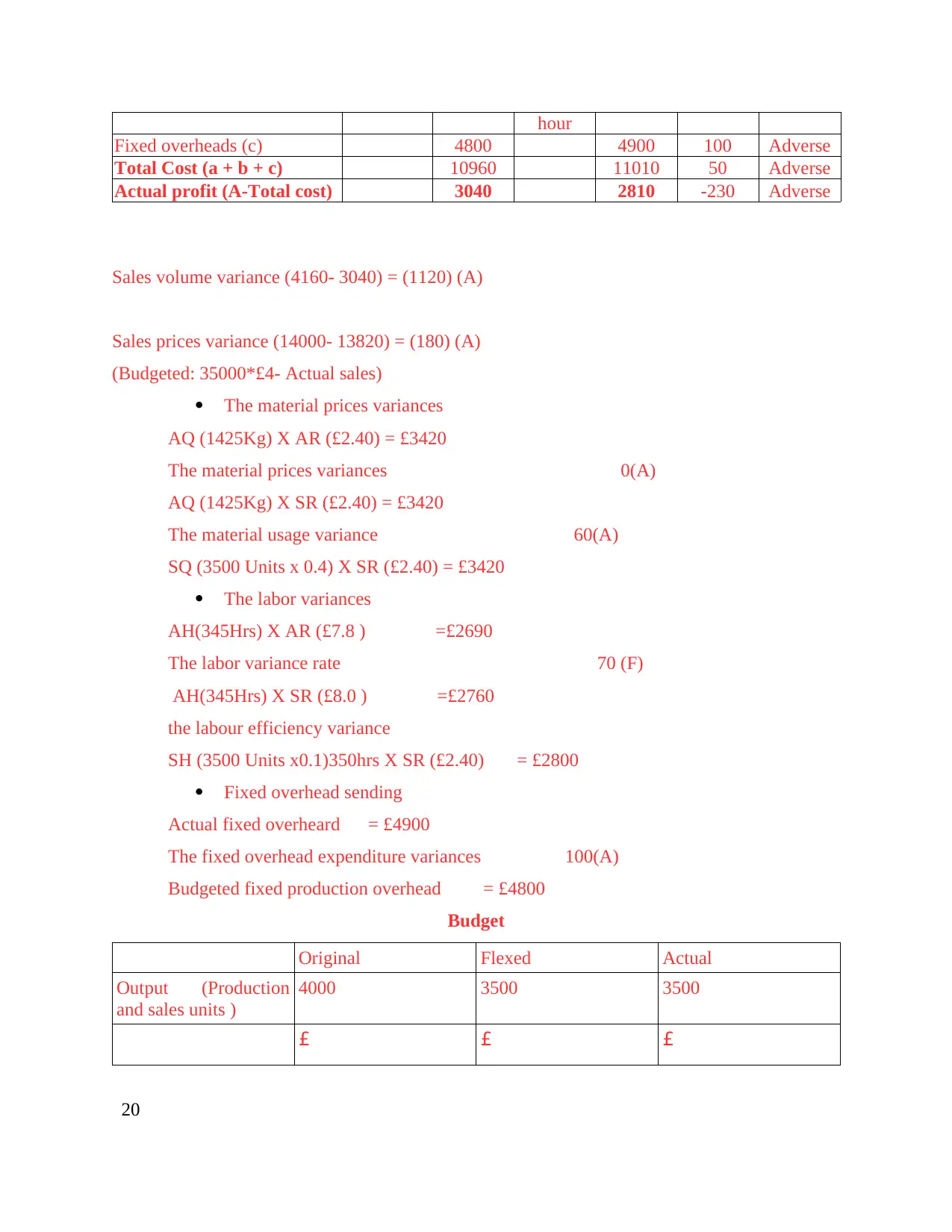
hour
Fixed overheads (c) 4800 4900 100 Adverse
Total Cost (a + b + c) 10960 11010 50 Adverse
Actual profit (A-Total cost) 3040 2810 -230 Adverse
Sales volume variance (4160- 3040) = (1120) (A)
Sales prices variance (14000- 13820) = (180) (A)
(Budgeted: 35000*£4- Actual sales)
The material prices variances
AQ (1425Kg) X AR (£2.40) = £3420
The material prices variances 0(A)
AQ (1425Kg) X SR (£2.40) = £3420
The material usage variance 60(A)
SQ (3500 Units x 0.4) X SR (£2.40) = £3420
The labor variances
AH(345Hrs) X AR (£7.8 ) =£2690
The labor variance rate 70 (F)
AH(345Hrs) X SR (£8.0 ) =£2760
the labour efficiency variance
SH (3500 Units x0.1)350hrs X SR (£2.40) = £2800
Fixed overhead sending
Actual fixed overheard = £4900
The fixed overhead expenditure variances 100(A)
Budgeted fixed production overhead = £4800
Budget
Original Flexed Actual
Output (Production
and sales units )
4000 3500 3500
£ £ £
20
Fixed overheads (c) 4800 4900 100 Adverse
Total Cost (a + b + c) 10960 11010 50 Adverse
Actual profit (A-Total cost) 3040 2810 -230 Adverse
Sales volume variance (4160- 3040) = (1120) (A)
Sales prices variance (14000- 13820) = (180) (A)
(Budgeted: 35000*£4- Actual sales)
The material prices variances
AQ (1425Kg) X AR (£2.40) = £3420
The material prices variances 0(A)
AQ (1425Kg) X SR (£2.40) = £3420
The material usage variance 60(A)
SQ (3500 Units x 0.4) X SR (£2.40) = £3420
The labor variances
AH(345Hrs) X AR (£7.8 ) =£2690
The labor variance rate 70 (F)
AH(345Hrs) X SR (£8.0 ) =£2760
the labour efficiency variance
SH (3500 Units x0.1)350hrs X SR (£2.40) = £2800
Fixed overhead sending
Actual fixed overheard = £4900
The fixed overhead expenditure variances 100(A)
Budgeted fixed production overhead = £4800
Budget
Original Flexed Actual
Output (Production
and sales units )
4000 3500 3500
£ £ £
20
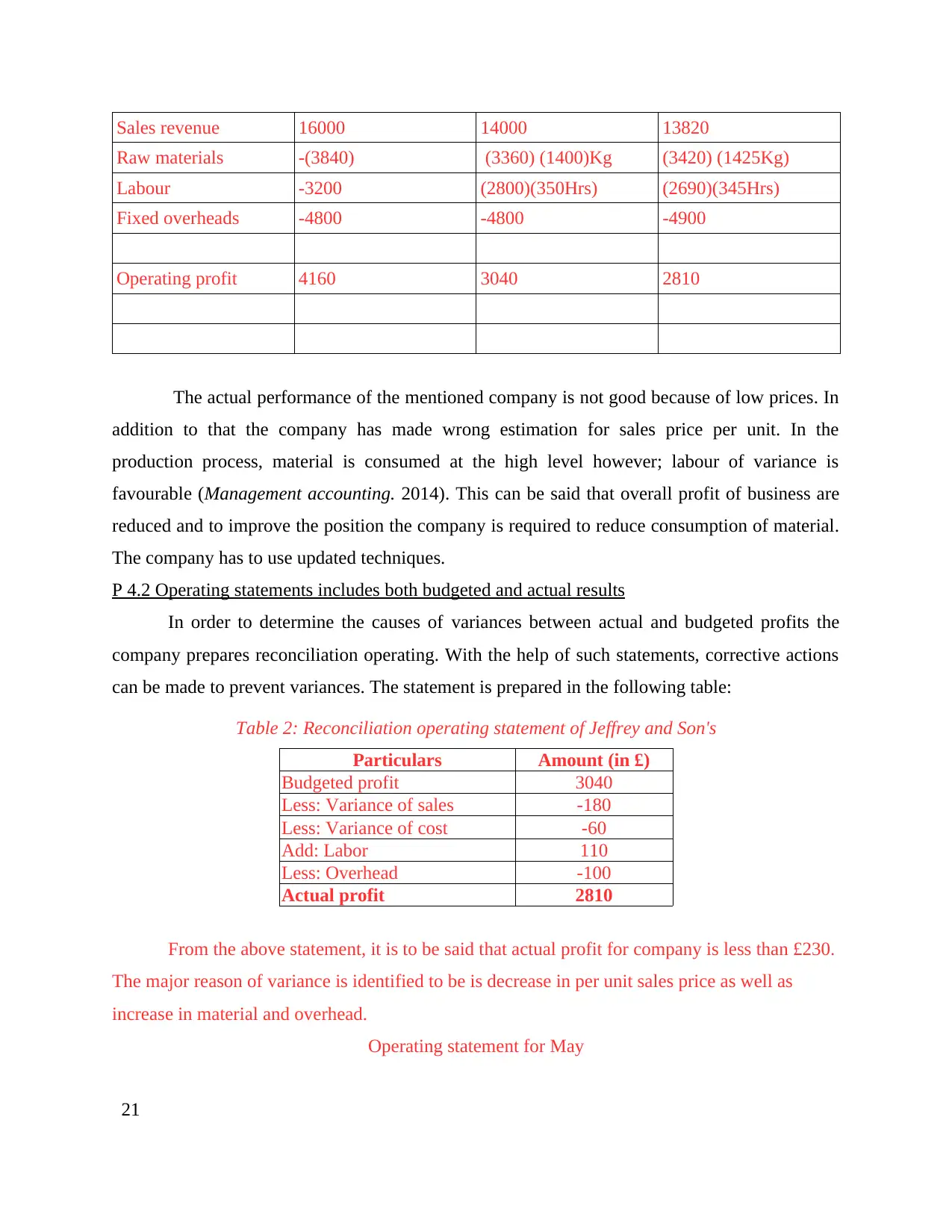
Sales revenue 16000 14000 13820
Raw materials -(3840) (3360) (1400)Kg (3420) (1425Kg)
Labour -3200 (2800)(350Hrs) (2690)(345Hrs)
Fixed overheads -4800 -4800 -4900
Operating profit 4160 3040 2810
The actual performance of the mentioned company is not good because of low prices. In
addition to that the company has made wrong estimation for sales price per unit. In the
production process, material is consumed at the high level however; labour of variance is
favourable (Management accounting. 2014). This can be said that overall profit of business are
reduced and to improve the position the company is required to reduce consumption of material.
The company has to use updated techniques.
P 4.2 Operating statements includes both budgeted and actual results
In order to determine the causes of variances between actual and budgeted profits the
company prepares reconciliation operating. With the help of such statements, corrective actions
can be made to prevent variances. The statement is prepared in the following table:
Table 2: Reconciliation operating statement of Jeffrey and Son's
Particulars Amount (in £)
Budgeted profit 3040
Less: Variance of sales -180
Less: Variance of cost -60
Add: Labor 110
Less: Overhead -100
Actual profit 2810
From the above statement, it is to be said that actual profit for company is less than £230.
The major reason of variance is identified to be is decrease in per unit sales price as well as
increase in material and overhead.
Operating statement for May
21
Raw materials -(3840) (3360) (1400)Kg (3420) (1425Kg)
Labour -3200 (2800)(350Hrs) (2690)(345Hrs)
Fixed overheads -4800 -4800 -4900
Operating profit 4160 3040 2810
The actual performance of the mentioned company is not good because of low prices. In
addition to that the company has made wrong estimation for sales price per unit. In the
production process, material is consumed at the high level however; labour of variance is
favourable (Management accounting. 2014). This can be said that overall profit of business are
reduced and to improve the position the company is required to reduce consumption of material.
The company has to use updated techniques.
P 4.2 Operating statements includes both budgeted and actual results
In order to determine the causes of variances between actual and budgeted profits the
company prepares reconciliation operating. With the help of such statements, corrective actions
can be made to prevent variances. The statement is prepared in the following table:
Table 2: Reconciliation operating statement of Jeffrey and Son's
Particulars Amount (in £)
Budgeted profit 3040
Less: Variance of sales -180
Less: Variance of cost -60
Add: Labor 110
Less: Overhead -100
Actual profit 2810
From the above statement, it is to be said that actual profit for company is less than £230.
The major reason of variance is identified to be is decrease in per unit sales price as well as
increase in material and overhead.
Operating statement for May
21

£ £ £
Favorable Adverse
Sales volume variance 1120
Sales price variance 180
Material price variance 0
Material usage
variance
60
Labor rate variance 70
Labor efficiency
variance
40
Fixed overhead
expenditure variance
100
Total variance 110 F 1460A
Total net variance -1350
Budgeted operating
profit
4160
Less: Net variance -1350
Actual operating profit 2810
P4.3 Responsibility centers
By undertaking the reconciliation operating statement of enterprise, following
departments of firm are required to alter their operating strategies so as to overcome variance and
they are as follows:
Production department: With the motive to reduce excess material consumption
production department of firm must employ advanced tools. Further, main focus must be on
reducing wastage by utilizing resources in effective manner (Tsay, 2008).
Human resource department: Labour variance of entity is favourable and this is leading
to rise in profitability level. Further, it is suggested to firm to indulge into forecasting as variance
is taking place due to decline in labour charges.
22
Favorable Adverse
Sales volume variance 1120
Sales price variance 180
Material price variance 0
Material usage
variance
60
Labor rate variance 70
Labor efficiency
variance
40
Fixed overhead
expenditure variance
100
Total variance 110 F 1460A
Total net variance -1350
Budgeted operating
profit
4160
Less: Net variance -1350
Actual operating profit 2810
P4.3 Responsibility centers
By undertaking the reconciliation operating statement of enterprise, following
departments of firm are required to alter their operating strategies so as to overcome variance and
they are as follows:
Production department: With the motive to reduce excess material consumption
production department of firm must employ advanced tools. Further, main focus must be on
reducing wastage by utilizing resources in effective manner (Tsay, 2008).
Human resource department: Labour variance of entity is favourable and this is leading
to rise in profitability level. Further, it is suggested to firm to indulge into forecasting as variance
is taking place due to decline in labour charges.
22
Secure Best Marks with AI Grader
Need help grading? Try our AI Grader for instant feedback on your assignments.
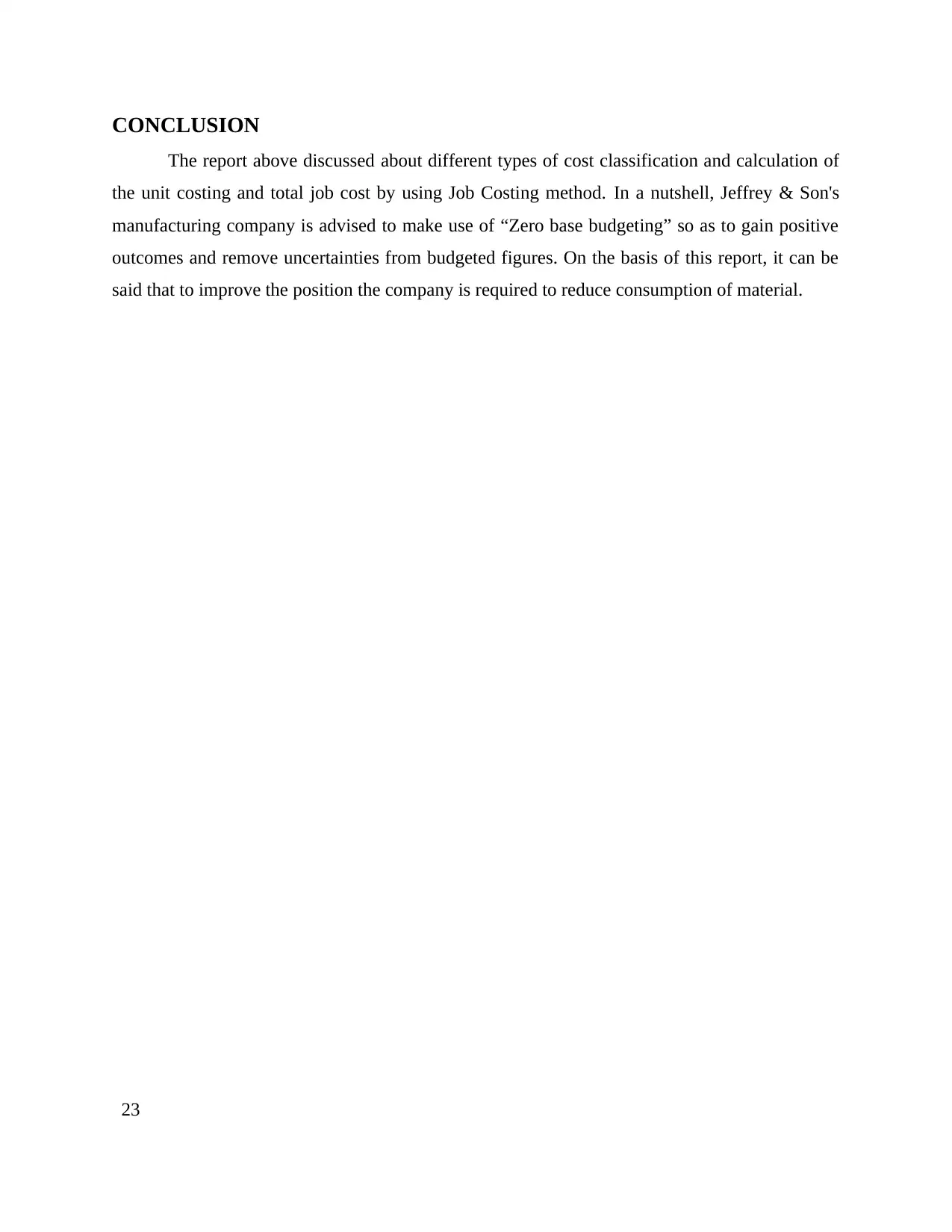
CONCLUSION
The report above discussed about different types of cost classification and calculation of
the unit costing and total job cost by using Job Costing method. In a nutshell, Jeffrey & Son's
manufacturing company is advised to make use of “Zero base budgeting” so as to gain positive
outcomes and remove uncertainties from budgeted figures. On the basis of this report, it can be
said that to improve the position the company is required to reduce consumption of material.
23
The report above discussed about different types of cost classification and calculation of
the unit costing and total job cost by using Job Costing method. In a nutshell, Jeffrey & Son's
manufacturing company is advised to make use of “Zero base budgeting” so as to gain positive
outcomes and remove uncertainties from budgeted figures. On the basis of this report, it can be
said that to improve the position the company is required to reduce consumption of material.
23

REFERENCES
Books and Journals
Baldvinsdottir, G., Mitchell, F. and Nørreklit, H., 2010. Issues in the relationship between
theory and practice in management accounting.Management Accounting Research, 21(2),
pp.79-82.
Banks, A., 2008. Budgeting. 3rd ed. McGraw-Hill Australia
Bhimani, A., and Bromwich, M., 2009. Management Accounting: Retrospect and prospect.
Elsevier.
Burns, J. and Scapens, R.W., 2000. Conceptualizing management accounting change: an
institutional framework. Management accounting research, 11(1), pp.3-25.
Cinquini, L. and Tenucci, A., 2010. Strategic management accounting and business strategy: a
loose coupling?. Journal of Accounting & organizational change, 6(2), pp.228-259.
Cooper, R. and Kaplan, R.S., 2008. How cost accounting distorts product costs. Management
accounting, 69(10), pp.20-27.
DRURY, C.M., 2013. Management and cost accounting. Springer.
Garrison, R.H., Noreen, E.W., Brewer, P.C. and McGowan, A., 2010. Managerial
accounting. Issues in Accounting Education, 25(4), pp.792-793.
Ho, J. C. L., Liu, S. C. and Tsay, J., 2008. Further evidence on financial analysts' reaction to
enterprise resource planning implementation announcements. Review of Accounting and
Finance. 7(3) pp. 213 – 235.
Kaplan, R.S. and Atkinson, A.A., 2015. Advanced management accounting. PHI Learning.
Keown, A., 2005. Financial management. Upper Saddle River, N.J.: Pearson/Prentice Hall.
Prior, P. B., 2004. Managing Financial Resources and Decisions. BPP Professional Education.
Vance, D., 2002. Financial Analysis and Decision Making. McGraw Hill Professional.
Ward, K., 2012. Strategic management accounting. Routledge.
Zikmund, W., 2012. Business research methods. John Wiley & Sons
Zimmerman, J.L. and Yahya-Zadeh, M., 2011. Accounting for decision making and
control. Issues in Accounting Education, 26(1), pp.258-259.
Online
24
Books and Journals
Baldvinsdottir, G., Mitchell, F. and Nørreklit, H., 2010. Issues in the relationship between
theory and practice in management accounting.Management Accounting Research, 21(2),
pp.79-82.
Banks, A., 2008. Budgeting. 3rd ed. McGraw-Hill Australia
Bhimani, A., and Bromwich, M., 2009. Management Accounting: Retrospect and prospect.
Elsevier.
Burns, J. and Scapens, R.W., 2000. Conceptualizing management accounting change: an
institutional framework. Management accounting research, 11(1), pp.3-25.
Cinquini, L. and Tenucci, A., 2010. Strategic management accounting and business strategy: a
loose coupling?. Journal of Accounting & organizational change, 6(2), pp.228-259.
Cooper, R. and Kaplan, R.S., 2008. How cost accounting distorts product costs. Management
accounting, 69(10), pp.20-27.
DRURY, C.M., 2013. Management and cost accounting. Springer.
Garrison, R.H., Noreen, E.W., Brewer, P.C. and McGowan, A., 2010. Managerial
accounting. Issues in Accounting Education, 25(4), pp.792-793.
Ho, J. C. L., Liu, S. C. and Tsay, J., 2008. Further evidence on financial analysts' reaction to
enterprise resource planning implementation announcements. Review of Accounting and
Finance. 7(3) pp. 213 – 235.
Kaplan, R.S. and Atkinson, A.A., 2015. Advanced management accounting. PHI Learning.
Keown, A., 2005. Financial management. Upper Saddle River, N.J.: Pearson/Prentice Hall.
Prior, P. B., 2004. Managing Financial Resources and Decisions. BPP Professional Education.
Vance, D., 2002. Financial Analysis and Decision Making. McGraw Hill Professional.
Ward, K., 2012. Strategic management accounting. Routledge.
Zikmund, W., 2012. Business research methods. John Wiley & Sons
Zimmerman, J.L. and Yahya-Zadeh, M., 2011. Accounting for decision making and
control. Issues in Accounting Education, 26(1), pp.258-259.
Online
24
1 out of 24
Related Documents
Your All-in-One AI-Powered Toolkit for Academic Success.
+13062052269
info@desklib.com
Available 24*7 on WhatsApp / Email
![[object Object]](/_next/static/media/star-bottom.7253800d.svg)
Unlock your academic potential
© 2024 | Zucol Services PVT LTD | All rights reserved.





